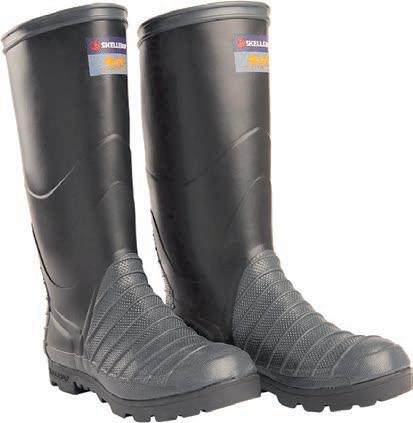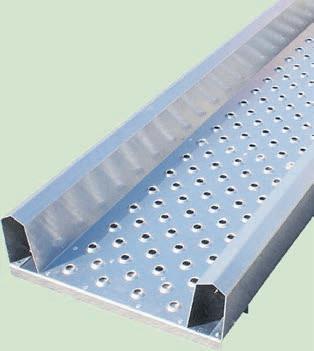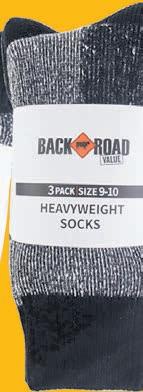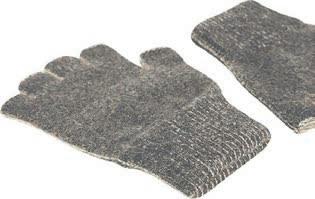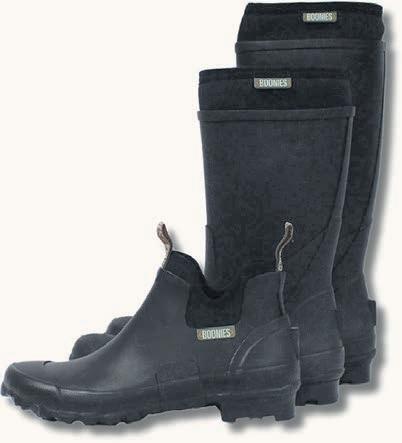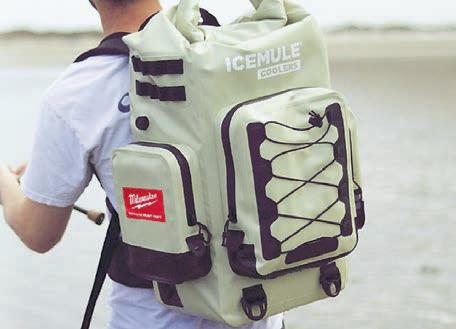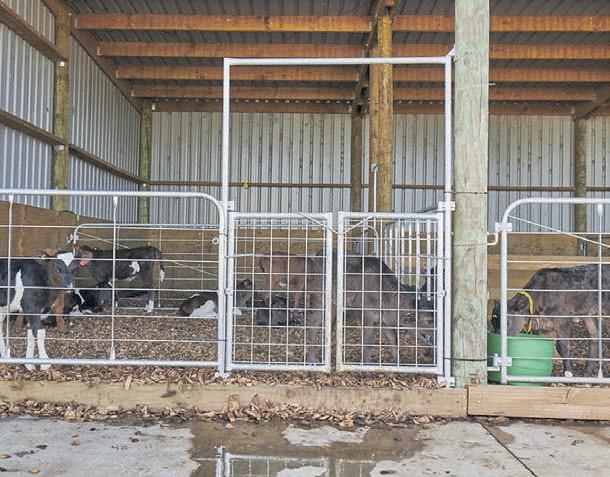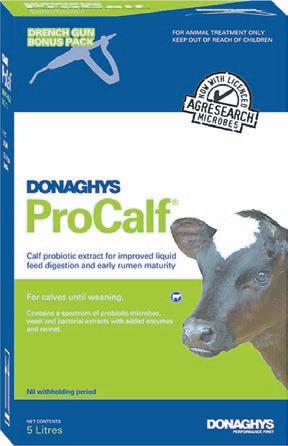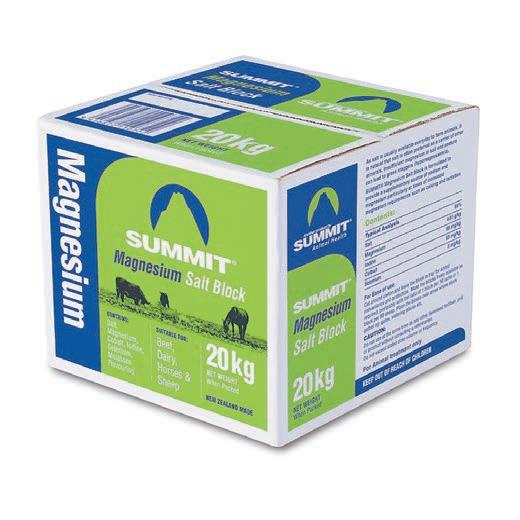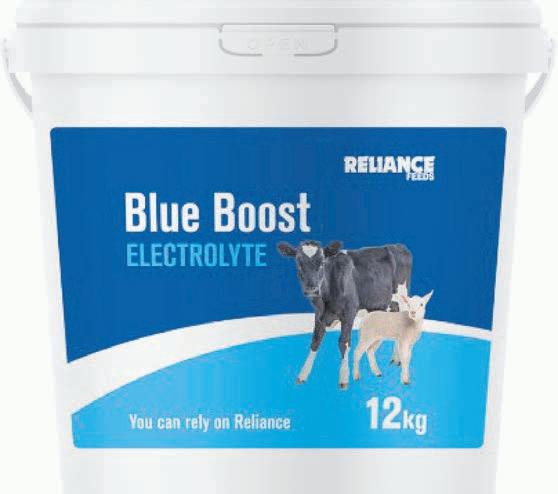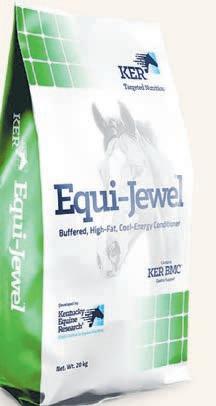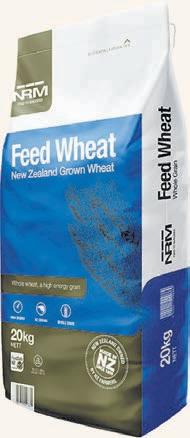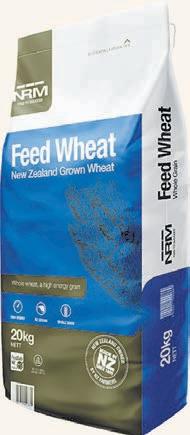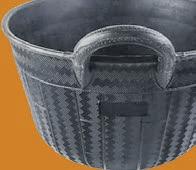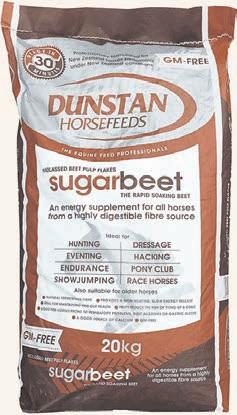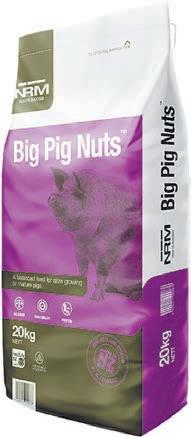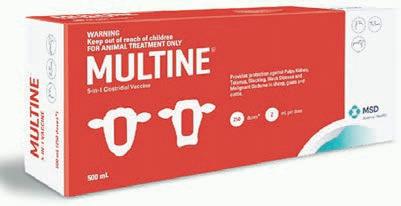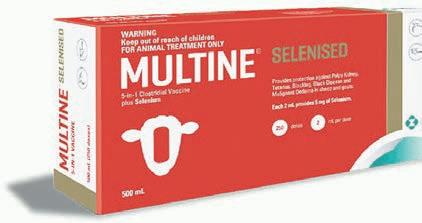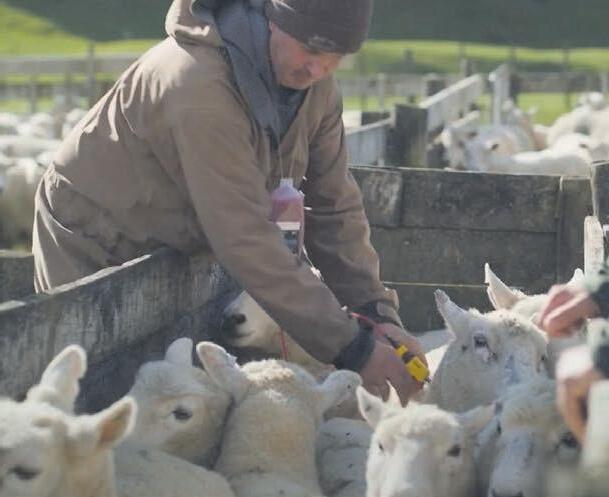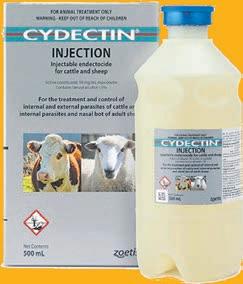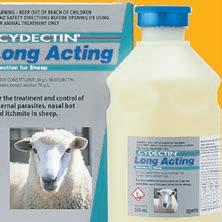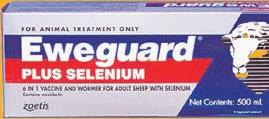

Keep it co-op plea as AGL vote looms

ALLIANCE Group shareholders are being asked to consider what they will forsake if they allow their meat company to lose its 100% farmer-owned cooperative status.
The AGL board will announce in the coming months its options to raise more than $200 million in new capital, and co-operative advocates are warning that any loss of farmer ownership also risks losing a price-setting entity and insurance for farmers to process stock when they require it.
James Lockhart, formerly a senior lecturer at the Massey Business School, conceded that time could be running out for Alliance to retain its co-operative status.
However, he said, sheep and beef prices have markedly improved on a year ago when the board sought fresh capital. At the time this was rebuffed by shareholders, but they may be more inclined to invest now.
“It’s a very different conversation to what we were having last year. There is still an opportunity to go to its farmer base,” Lockhart said.
Alliance chair Mark Wynne said commercial sensitivities and confidentiality agreements limit what can be shared with shareholders.
“We will be providing another update to our farmers later this month ahead of a series of road show meetings followed by a formal shareholder vote in the next few months.”
He said Alliance has the full support of its banking syndicate, with continued financing.
“There is confidence in our performance, in the capital raise process, the investor offers and our farmer-shareholders.”
Wynne said Alliance needs more than $200m to strengthen its balance sheet and provide a more stable financial foundation for the business.
“We’re in an advanced stage of assessment and working towards confirming a preferred option for our farmer-shareholders,” he said.
There are rumours Alliance has interest from several parties, both overseas and domestic.
Lockhart said he believes banks would support a two-stage capital raise process from shareholders – a portion now with plans to raise the balance at a later date.
He said the capital raise issue has clouded discussion about Alliance’s strategy and its procurement policy.
Three of its largest shareholders are livestock brokers and while Alliance has reduced its reliance on traders, he believes as a cooperative it should stop using them altogether.
“They have ended up with a

‘Empty nester’ takes Kobi under his wing
Ex-chartered accountant ‘empty nester’ Mark Withers has given 12-year-old Kobi a taste of rural life, sharing visits to the family farm as part of the Big Buddy programme, which provides support for boys who do not have a father in their lives.

Farming a guiding star for shepherd
Puhirere Tau says being a Māori farmer makes him no better, different or otherwise, but there are some Māori values that have deeply connected him with the land.
Words carry weight so careful how you use






Neal Wallace NEWS Production
Get in touch
EDITORIAL
Bryan Gibson | 06 323 1519
Managing Editor bryan.gibson@agrihq.co.nz
Craig Page | 03 470 2469 Deputy Editor craig.page@agrihq.co.nz
Claire Robertson
Sub-Editor claire.robertson@agrihq.co.nz
Neal Wallace | 03 474 9240
Journalist neal.wallace@agrihq.co.nz
Gerald Piddock | 027 486 8346
Journalist gerald.piddock@agrihq.co.nz
Annette Scott | 021 908 400 Journalist annette.scott@agrihq.co.nz
Hugh Stringleman | 027 474 4003
Journalist hugh.stringleman@agrihq.co.nz
Richard Rennie | 027 475 4256
Journalist richard.rennie@agrihq.co.nz
Nigel Stirling | 021 136 5570
Journalist nigel.g.stirling@gmail.com
PRODUCTION
Lana Kieselbach | 027 739 4295 production@agrihq.co.nz
ADVERTISING MATERIAL
Supply to: adcopy@agrihq.co.nz
SUBSCRIPTIONS & DELIVERY
0800 85 25 80 subs@agrihq.co.nz
PRINTER
Printed by NZME
Delivered by Reach Media Ltd
Advertise
SALES CONTACTS
Andy Whitson | 027 626 2269
Sales & Marketing Manager andy.whitson@agrihq.co.nz
Janine Aish | 027 300 5990
Auckland/Northland Partnership Manager janine.aish@agrihq.co.nz
Jody Anderson | 027 474 6094
Waikato/Bay of Plenty Partnership Manager jody.anderson@agrihq.co.nz
Palak Arora | 027 474 6095
Lower North Island Partnership Manager palak.arora@agrihq.co.nz
Andy Whitson | 027 626 2269
South Island Partnership Manager andy.whitson@agrihq.co.nz
Julie Hill | 027 705 7181
Marketplace Partnership Manager classifieds@agrihq.co.nz
Andrea Mansfield | 027 602 4925
National Livestock Manager livestock@agrihq.co.nz
Real Estate | 0800 85 25 80 realestate@agrihq.co.nz
Word Only Advertising | 0800 85 25 80 Marketplace wordads@agrihq.co.nz
PUBLISHERS
Dean and Cushla Williamson Phone: 027 323 9407 dean.williamson@agrihq.co.nz cushla.williamson@agrihq.co.nz
Farmers Weekly is Published by AgriHQ PO Box 529, Feilding 4740, New Zealand Phone: 0800 85 25 80 Website: www.farmersweekly.co.nz
ISSN 2463-6002 (Print) ISSN 2463-6010 (Online)
25-28
News in brief
Dairy down
Dairy values took a tumble at the latest GDT auction with the price index falling 4.1% to US$4274 a tonne.
Nearly all of the product categories fell in value, with whole milk powder taking the largest dive, down 5.1% to US$3859/t. Butter fell 4.3% to US$7522/t and AMF fell 4.2% to US$6,928/t.
Cheddar was down 2.8% to US$4860/t, skim milk powder fell 1.7% to US$2718/t and mozzarella was back 0.2% to US$4790/t.
Health online
The government’s 24/7 telehealth service to help people see a GP or a nurse is now available anywhere in the country.
The service started on Tuesday and will help those struggling to get an appointment with their regular GP or outside normal hours.

DUOPOLY: Troy Baisden, copresident of the NZ Association of Scientists, says there does not appear to be any real shift in focus for new PROs, with a continuing commercial emphasis risking even more intense scrambling for limited funds.
P12
Doctors and nurse practitioners can assess symptoms, diagnose conditions, prescribe medications, and provide referrals – all from wherever the patient is.
Scotland win
Scotland proved too good for New Zealand in the first of the Wools of New Zealand shearing team’s six tests in the United Kingdom at the Lochearnhead Shears in Scotland.
The Scotland team of Gavin Mutch and Calum Shaw beat Northlander Toa Henderson and King Country shearer Jack Fagan by 2.9 points.
Foulbrood plan
The New Zealand Bee Health and Biosecurity Trust will implement and enforce the National American Foulbrood Pest Management Plan.
The new management agency will take over management of the plan from July 1. Biosecurity Minister Andrew Hoggard said the NZBB, a new registered charitable trust of the current AFB Management Agency board, will bring experience.

Food provides a pathway to Asian links

Richard Rennie MARKETS Trade
NOODLES, dim sum and fried rice have all played a part in making New Zealanders’ understanding of Asia greater than it has ever been, a recent survey shows.
The annual Asia New Zealand Foundation’s Perceptions of Asia survey has found Kiwis have a growing confidence and comfort about Asia’s role in their lives, and food has had a big part to play in this.
The survey found that “China” and “Chinese” remain the most common word association with Asia for the sixth year running. But Asian food and cuisine are the second top-of-mind link for New Zealanders, including many of the diverse dishes served up across the populous continent.
Asian restaurants and more recently supermarkets have played a big part, with the likes of Auckland’s Foodie Asian Supermarket turbo charging shopping choices for a growing Asian population base.
Asia-New Zealand Foundation researcher Dr Julia Macdonald said
Continued from page 1
halfway house but they should go the whole way and internalise procurement.

food is proving an increasingly common pathway to growing understanding of Asian culture, particularly as traditional media intake is diminishing in the population.
The foundation’s survey, which was established 28 years ago, interviews 2300 New Zealanders on their attitudes towards Asia.
This year’s survey contained some new questions, reflecting
“It will only strengthen the relationship between drafters and the supplier-shareholders, from which they can only benefit and remove costs, noise and rhetoric.”
He said the biggest benefit of a co-operative is that in one
growing tensions across the region as China flexes its military muscle, and also asked how New Zealanders find their news on Asia.
A key finding was that 80% of New Zealanders understood it is “important-very important” for NZ to develop political, economic and social ties with Asia. This is up 20% from only five years ago and was reinforced by New Zealanders’ knowledge of
payment it gives shareholders the value of the animal and market return.
Shareholder Andrew Morrison welcomed a board briefing that states Alliance is trading according to budget and on track to return to profit after two years of substantial losses.
“It shows they have made significant changes, so how does that equate to what decision farmers are about to face?”
Morrison said shareholders need to know what a potential investor offers in addition to cash, such as supply chain efficiencies or commercial discipline.
He urges shareholders to study and understand the implications
Asia also being at an all-time high.
Sixty percent of those surveyed said they know at least a “fair amount” about the region, almost double what it was in 2013. Those under 30 exhibited the greatest understanding of Asia.
Interestingly, that awareness has come at the same time respondents’ awareness of other world regions has dropped off.
Social media is playing the biggest part in growing that understanding, with the percentage of people recalling reading anything about Asia in traditional media in the past three months now sitting at an all-time low of 37%. This is half what it was in 2015.
The report authors note finding media channels that reach a broad range of New Zealanders is likely to be an ongoing challenge.
“And it is also noticeable in the survey more New Zealanders are very concerned about the level of misinformation those sources can bring with them,” said Macdonald.
Meantime, as China starts to flex its muscles in the Pacific, the survey has found New Zealanders are balanced 40:40 about how our economic interests with Asia play off against democratic values, with 19% undecided.
of the decision they are about to make.
Lincoln University agribusiness
Professor Hamish Gow said co-operatives such as Alliance effectively set stock prices and act as a toll processor, as Fonterra does to the dairy industry.
“If you lose co-operatives you lose a competitive yardstick that keeps prices fair,” Gow said.
Losing co-operative status could require farmers to change supply patterns.
It could mean losing the processing capacity that currently allows shareholders to get stock processed as needed.
“The pressure will go back on farmers to change their business
While New Zealanders’ views on Asia are generally positive, and that includes China, that country’s recent naval activities in the Tasman Sea and the deal with the Cook Islands have undone increasingly positive perceptions.
Food is proving an increasingly common pathway to growing understanding of Asian culture, particularly as traditional media intake is diminishing in the population.
Dr Julia Macdonald Asia-New Zealand Foundation
However, that decline is also shared with New Zealanders’ views on the United States, now equally regarded as both a “threat” and a “friend” for the first time ever.
“This comes after a period when the US has been regarded highly as a friend. It’s drop has occurred with other countries around the world too.”
All other Asian countries have received their highest ever positive ratings when viewed on a “friendliness” scale.
model to delivering animals when processors want them.
“The reason we have traditionally had co-operatives is that it allows us to get fair prices, run farms the way we want to and as an insurance mechanism to get livestock processed when shareholders want it.”
Former Federated Farmers meat and wool chair Toby Williams hopes to initiate a broader discussion on solutions to issues facing the sector and avoid the current scenario where companies are waiting to see who blinks first.
“It needs a catalyst instead of a decision maker. If we carry on the way we are, no one is going to win.”
ANZCO
C ompanies whose employees and contractors come on to your
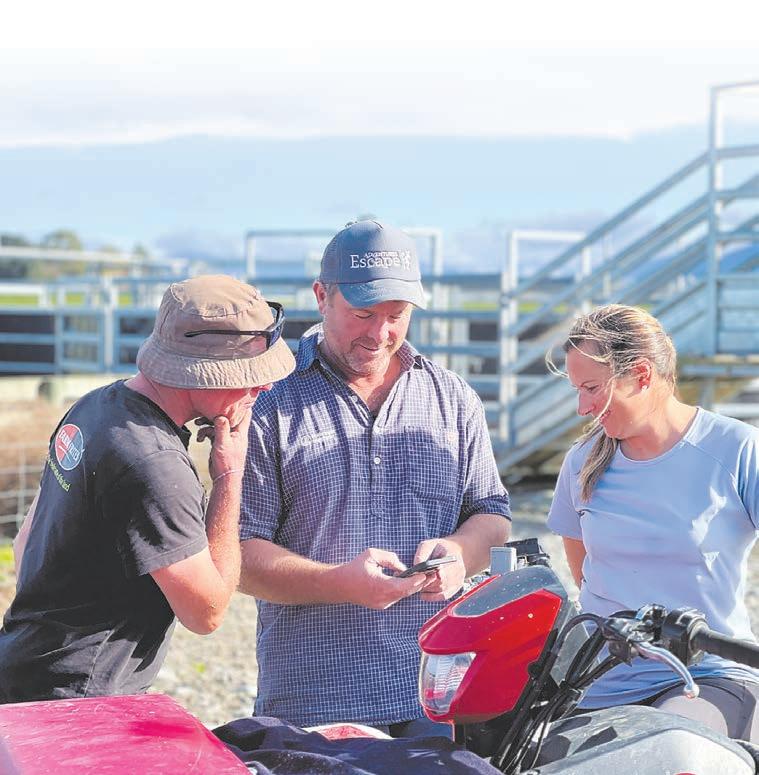
TASTY: For many New Zealanders, Asian food is now their gateway to better understanding of the region, its culture and its importance to the NZ economy.
Three Lone Star farms seek right buyer

Neal Wallace NEWS Sheep and beef
ONE of the South Island’s largest sheep and beef farmers, Lone Star Farms, has put three properties on the market as its 75-year-old owner prepares for the future.
Tom Sturgess, the founder of Lone Star Farms, said he has spent upwards of 30 years farming and wants to ensure the business goes to an owner who has a perspective and values that align with his.
The three farms are being offered together under a tender, but it is not a given that he will sell them.
“If that does not happen, then great, we will soldier on.”
Lone Star owns six farms from Nelson to Otago and is seeking to sell Caberfeidh Station, a 6000 hectare farm at Kurow in North Otago and two farms near Middlemarch inland from Dunedin, The Wandle, 2600ha, and Barewood, 6420ha.
The three hill country properties have about 25 staff and carry

M73,000 stock units on 12,400ha effective. Lone Star will retain Stradbrook, 495ha at Mayfield in Mid Canterbury, and two Tasman properties, Quartz Range, 1050ha at Collingwood and Puramahoi, 200ha at Takaka. Combined they run 10,300 stock units on 1250ha effective.
Sturgess describes the three
farms he is selling as strong units, profitable and the core of Lone Star’s breeding business.
Lone Star is one of the largest suppliers to the Lumina Lamb programme and Sturgess said if the farms sell, it will be up to the new owners whether they continue to be suppliers.
The farming company will
bovis compo service wraps up
Staff reporter NEWS Disease
THE compensation assistance service set up during the Mycoplasma bovis outbreak has been disestablished. It helped 1370 farmers in the seven years it was in operation.
Set up in 2018, the DairyNZ Beef + Lamb New Zealand Compensation Assistance Team (DBCAT) helped finalise more than 2310 claims.
More than $161 million in claims were submitted by the service on behalf of farmers, including $88m from dairy farmers and $40m from beef farmers.
It is estimated that the service saved the M bovis eradication programme more than $10m by finding smart farm-systems solutions that mitigated the need for a claim.
The service played an important part in supporting farmers through a tough time, DairyNZ head of biosecurity Fi Roberts said.
“We know how hard it was for farmers, which is why we wanted to support those affected by getting them through the compensation claim process as quickly as we could.
“By having a dedicated team, claims could be processed faster and farmers compensated more quickly.”


Beef + Lamb New Zealand (BLNZ) chair Kate Acland said DBCAT played an important role in helping farmers navigate what was one of the toughest times in their farming careers.
“The service not only made the compensation process more accessible and efficient, but it also ensured farmers had someone in their corner who understood their operation and their stress.
“We’re proud of the partnership that delivered this support and of the legacy DBCAT leaves in showing how the sector can come together in a time of need.”
DairyNZ partnered with the Ministry for Primary Industries and BLNZ to lead the response
still be finishing up to 40,000 lambs a year through its own and leased farms and share-farmed properties.
Sturgess said through the skill and dedication of his staff, the six Lone Star farms have become highly productive units.
Lambing percentages are consistently between 145% and 155% and lambs are slaughtered between 19.5kg and 20.5kg.
The Lumina contract requires lambs to be finished on chicory crops prior to slaughter and Sturgess said they have reduced the time to reach target weights from 80 days to 40 days through refined management.
Between 92% and 95% of lambs offered for the contract are accepted.
When Sturgess moved from the United States to Nelson and bought his first farm, he said the friendliness and politeness of New Zealanders simplified the farming transition while a network of advisers and staff helped him develop and manage the properties.
His skill lies in running and the ethos of creating a safe workplace,

he said, ensuring high standards of human and animal welfare and environmental management and addressing issues such as methane emissions.
“I’m much more use at that level. They probably don’t want me in the shearing shed.”
The properties have been listed for only a few weeks but he said they have already attracted inquiry and interest.
The tender closes in November.
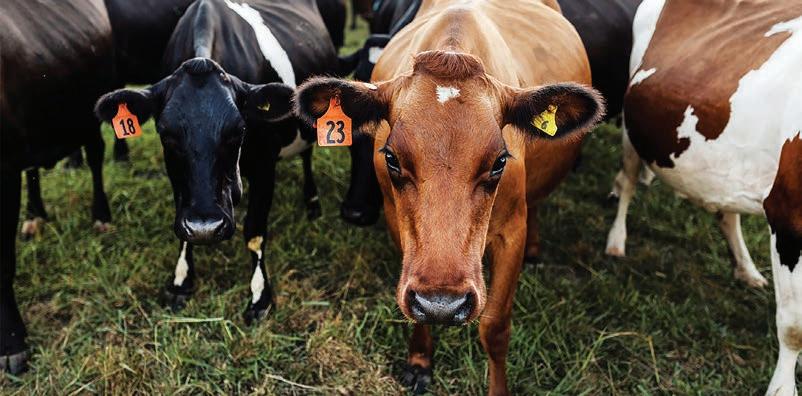
CLEAR: The M bovis programme is now seven years into a 10-year eradication plan, with currently no active, confirmed properties.
phase of the M bovis eradication programme.
The M bovis programme is now seven years into a 10-year eradication plan, with currently no active, confirmed properties. The programme transitioned to the M
bovis National Pest Management Plan (NPMP) on January 1 this year, and is now implemented by OSPRI.
The DBCAT service closed on June 30. The MPI will handle any new or unresolved claims directly.

TENDER: Caberfeidh Station, a 6000ha farm at Kurow in North Otago, is one of three farms being sold by tender through Sotheby’s International Realty.
RIGHT FIT: Lone Star Farms founder Tom Sturgess is selling three of his hill country properties – but only if he finds the right buyer.
Horse trading on US tariffs gathers pace

SNigel Stirling POLITICS Trade
OME of New Zealand’s biggest exporters say they have yet to feel the full force of United States President Donald Trump’s tariffs nearly three months after they were announced.
This comes as Trump is due to announce further details on where tariffs might settle for US trading partners.
The 90-day pause on the highest tariffs to allow for further negotiations ends on Thursday.
Fonterra’s director of global stakeholder affairs, Simon Tucker, doesn’t expect the 10% tariff announced on NZ exports on April 5 to be altered.
“It does feel that the US is so deep in multiple negotiations that NZ is probably not on anyone’s immediate agenda,” he said.
Government data shows NZ’s total dairy exports to the US in April and May were $208 million, up 21% from the year before.
“The demand picture particularly for the high-value protein products we are selling into the US is really strong and in many cases are very difficult to
source from elsewhere because of the intellectual property that is tied up in them,” Tucker said.
However, long-term contracts with many US customers mean the full impact of the tariffs wouldn’t be known until those contracts are re-negotiated.
“On that continuum between the customer paying 100% of the tariff and us paying 100%, it is too early to know where the balance is going to lie.
“With many of our customers in the US we are working on pricing agreements stretching out for years.
“In some cases it is going to be a long-term answer what the actual impact is because there is still a lot to work through.
“These are big, multi-year deals and we are not rushing them.”
For lamb, ANZCO’s general manager of sales, Rick Walker, said three of NZ’s four biggest meat exporters – ANZCO, Alliance and Silver Fern Farms – export directly to the US-based Lamb Company, which they also are shareholders in.
It is up to the Lamb Company as the importer of record to either pass on the tariff to its customers or absorb the cost itself.
Walker said there is not the

We certainly have walked away from a lot of deals in the grinding beef space in the last three months.
Rick Walker ANZCO
same protection from longer-term pricing agreements as is typical in the dairy industry.
“It is more week to week,” he said. If the tariff cannot be recovered through higher prices from the Lamb Company’s customers, it will eventually be felt in lower dividends back to its shareholders.
“We are just starting to get into the window where all that product flowing through into the Lamb Company is now flowing through to their end users.
“We are already pushing pretty hard on price and the Lamb Company is adding more on top of that to get back some of the tariff so it will be interesting to see over the next three months whether it has an impact on consumption.”
For manufacturing beef, which accounted for the vast bulk of NZ’s $1.8 billion of beef exports to the US last year, customers had been pushing exporters hard to pay the tariff, Walker said.
Increased competition from Australian and Brazilian imports has not helped the bargaining
MAKING A POINT: United States President Donald Trump is due to announce further details on where tariffs might settle for US trading partners.
position of NZ exporters.
“Their position has been relatively consistent that the full 10% tariff sits with us.
“We certainly have walked away from a lot of deals in the grinding beef space in the last three months.
“We have moved more into other markets and customers such as the Lamb Company that are willing to absorb the cost.”
Prime beef has continued its strong run of the past 18 months, however, and buyers have been more prepared to share the cost of the 10% tariff with exporters, Walker said.
“Which is a reflection of their desperation to ensure security of supply.”
Exporters hit with spike in shipping costs

Exports
A SPIKE in the cost of moving containers by sea has come at the wrong time for exporters as they sit down with shipping lines to negotiate prices for next season.
Exporters had been hopeful of some sharp pricing after spot rates took a tumble in April and May in the wake of the United States and China’s tit for tat tariffs.
Triple-digit tariffs had brought trade between the two countries to a standstill, causing a sudden and massive overcapacity problem for shipping lines.
The indications we have from shipping lines is that the Red Sea is unlikely to open in the near term.
Santiago Aon Fonterra
Shipping analyst Drewry’s World Container Index fell to a low of US$2076 per 40-foot container in May, compared to nearly US$4000 earlier in the year.
But the index was back above US$3500 last month after a pause in the China-US trade war brought a resumption in exports and better
use of ships travelling between the two countries.
Mike Knowles of the New Zealand Council of Cargo Owners said negotiations between exporters and shipping lines typically begin around the middle of the year. Exporters contract the entire season’s production, rather than take their chances on the spot market, or risk missing out on shipping space altogether. Shipping is a material cost for
NZ exporters, with one exporter telling Farmers Weekly it makes up 4% of its cost of goods sold.
Knowles said there had been some hope earlier low spot rates would persist, giving exporters a stronger hand in upcoming negotiations.
“That didn’t eventuate,” he said.
And now conflict in the Middle East is adding to operating costs for the shipping companies.
While oil prices have retraced
the double-digit increase of the first few days of the Iran-Israel conflict, higher war risk premiums for insuring vessels travelling to the region persist.
Premiums have tripled from 0.125% of ship values just a couple of months ago to 0.25-0.45% last week.
The conflict also appears to have dashed hopes for unblocking a vital route to Europe.
Since late 2023 exports usually
routed through the Red Sea and then the Suez Canal on their way to Europe have had to take a 14day detour round the Cape of Good Hope to avoid being fired upon by Iranian-backed rebels in Yemen.
Fonterra’s director of global supply chain, Santiago Aon, said there had been reports of a ceasefire in Yemen and a halt to attacks on shipping clearing the way for normal services to resume within six to 12 months.
COSTS: Shipping is a material cost for NZ exporters, with one exporter telling Farmers Weekly it makes up 4% of the cost of goods sold.

“That was before the events of the last couple of weeks unfolded.
“The indications we have from shipping lines is that the Red Sea is unlikely to open in the near term.
“At the moment the surcharge that was imposed 18 months ago remains.”
Knowles, who is also shipping manager at kiwifruit marketer Zespri, said the global shipping market had been threatening to swing into a period of oversupply prior to the Red Sea disruptions. He doesn’t expect a rush to resume normal services to Europe.
“That came at a perfect time for the shipping companies because they had a wave of new buildings [of ships] ordered over the covid period.
“The big concern was where are they all going to go but the Red Sea [disruption] came along and hoovered them all up.”
Photo: Wikimedia Commons
Nigel Stirling NEWS


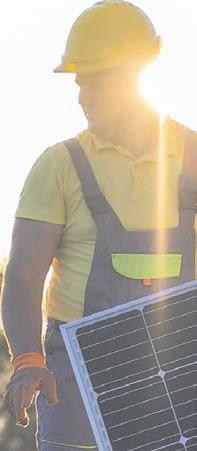


UK firm goes for NZ’s greener cannabis

Richard Rennie NEWS Horticulture
AMEDICINAL cannabis company that received the second largest of the Sustainable Food and Fibre Futures grants is starting to return dividends, having just signed a major supply deal with a leading United Kingdom-based pharmacy group.
In 2022 Blenheim-based Puro was granted $13 million over five years for its medicinal cannabis genetic breeding and organic production programme.
The family-owned company put $19m into the project, which focuses on outdoor grown organic cannabis on a farm near Blenheim owned by the MacFarlane family.
CEO Sank MacFarlane told Farmers Weekly the deal was for £7m (NZ$15.7m) to supply IPS Pharma.
The company specialises in providing access to unlicensed and hard-to-find medicines (“specials”), offering over 20,000 formulations from global suppliers.
MacFarlane said it was only thanks to law changes in NZ last year that the company was able to advance its international reach. Prior to the rule changes
it had been almost impossible for local companies to export their products.
“That really was the gate-opener for us. We have started to get some really good momentum, particularly into Australia now, and this just takes us a step further,” he said.
The medicinal cannabis industry has had a rollercoaster ride since it was legalised in April 2020, with export regulations stymieing access to growing overseas demand, while GPs in NZ have remained reluctant to prescribe cannabis-based drugs.
We have started to get some really good momentum, particularly into Australia now.
Sank MacFarlane Puro
Big operator Cannasouth, which was listed on the NZX in 2019, stumbled and was taken over by competing company Eqalis in 2023. Aether Pacific went into liquidation in February, and Greenfern went into receivership.
Under the terms of the Sustainable Food and Fibre Futures fund, Puro is required to publish quarterly progress reports,
and it had a mid-term audit conducted earlier this year, due to be published soon.
One of Puro’s goals was to be employing 200 fulltime staff by 2026 and be achieving $100m a year revenue by 2031.
MacFarlane said he doubted the 200 staff target would be reached by 2026.
“The KPI objectives were pretty high. But I do think we will eventually come close to those numbers.”
The UK deal involves Puro supplying cannabis flower heads initially but may include other products in future.
Puro is one of only a few certified organic cannabis growers globally and has developed a seven stage “live drying” process that maintains the plant’s potency and its therapeutic value.
MacFarlane acknowledged his company, like the industry itself, has had a tough few years getting established. However, he believes the sector is entering a more mature phase, with companies identifying their strengths, and sticking to their lanes.
Sally King, executive director of the NZ Medical Cannabis Council, said the Puro deal came on the back of a delegation visit to Europe that had been met with a very positive reception.
“The regulation changes last
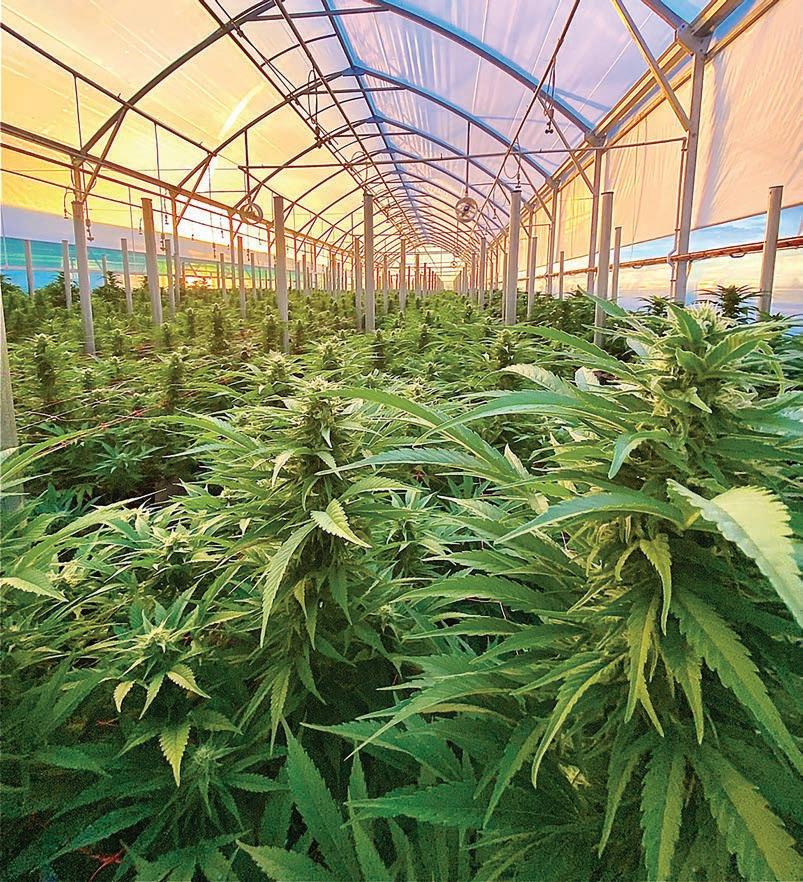
year certainly have made a significant difference. It takes a while for a change in legislation to translate to sales, but that is now happening. Everyone came back pretty pumped.”
She said customers recognised

NZ’s unique growing skills, and this country’s pure growing environment.
“And we also have a very trusted regulator, something that makes a difference in the cannabis sector.”





GREENER: Puro’s organic cannabis flowers have drawn strong interest from northern hemisphere distributors and pharma companies.
NZ not entirely in step with ‘new normal’

Richard Rennie MARKETS Food and fibre
ITH covid being five years in the world’s rear-view mirror, a McKinsey consumer report highlights how some pandemic actions have become embedded habits for food consumption and spending behaviour.
Dr Meike Rombach, senior lecturer in marketing and horticulture at Lincoln University, said the report paints a generally accurate picture of how consumers continue to behave but also points to areas where New Zealand varies from the “new normal”.
Surveying 25,000 consumers globally, the report found some habits adopted quickly and by compulsion over covid continue to linger when it comes to food consumption.
E-commerce’s continuing boom times trace back to lockdowns, and rates remain high with 90% of Chinese and United States consumers surveyed saying they shopped at an online-only retailer in the past month.
Forty percent of German, United
Kingdom and US consumers used online grocery delivery in the past week.
“Consumers get used to this convenience and they complement the other outlets, now including specialty stores and farmers markets.”
However, Rombach believes New Zealand consumers have not adapted as much as other nations to the increased isolation online purchasing brings.
This ‘splurge or save’ approach is where consumers still spend, but very purposefully choose what they spend it on.
Dr Meike Rombach Lincoln University
The report found US consumers report over three hours more free time a week than in 2019, usually spent online or relaxing independently rather than with friends and family, which has remained relatively flat.
The report found Gen Zs (born 1996-2010) had a more negative sentiment towards the world than
before covid, particularly about the cost of living.
But this contrasted to their spending habits, which still tend to see them “splurge” on specific special items, including food.
“This ‘splurge or save’ approach is something I call ‘selective frugality’ where consumers still spend, but very purposefully choose what they spend it on. It reflects what their values are, what are the values behind the food they buy and choose to put their money into.”
Convenience and direct delivery of food is one area Gen Z is prepared to pay a premium for.
A higher share of Gen Z respondents said they use grocery and food delivery services compared with members of any other generation.
Rombach said NZ exporters are also well positioned in Asian markets, particularly where NZsourced products are generally regarded as premium, quality and safe food options.
Gen Z is on track to eclipse Boomers’ global spend by 2029 and to be the largest, wealthiest generation in human history.
“We are also seeing here in NZ with this generation looking at
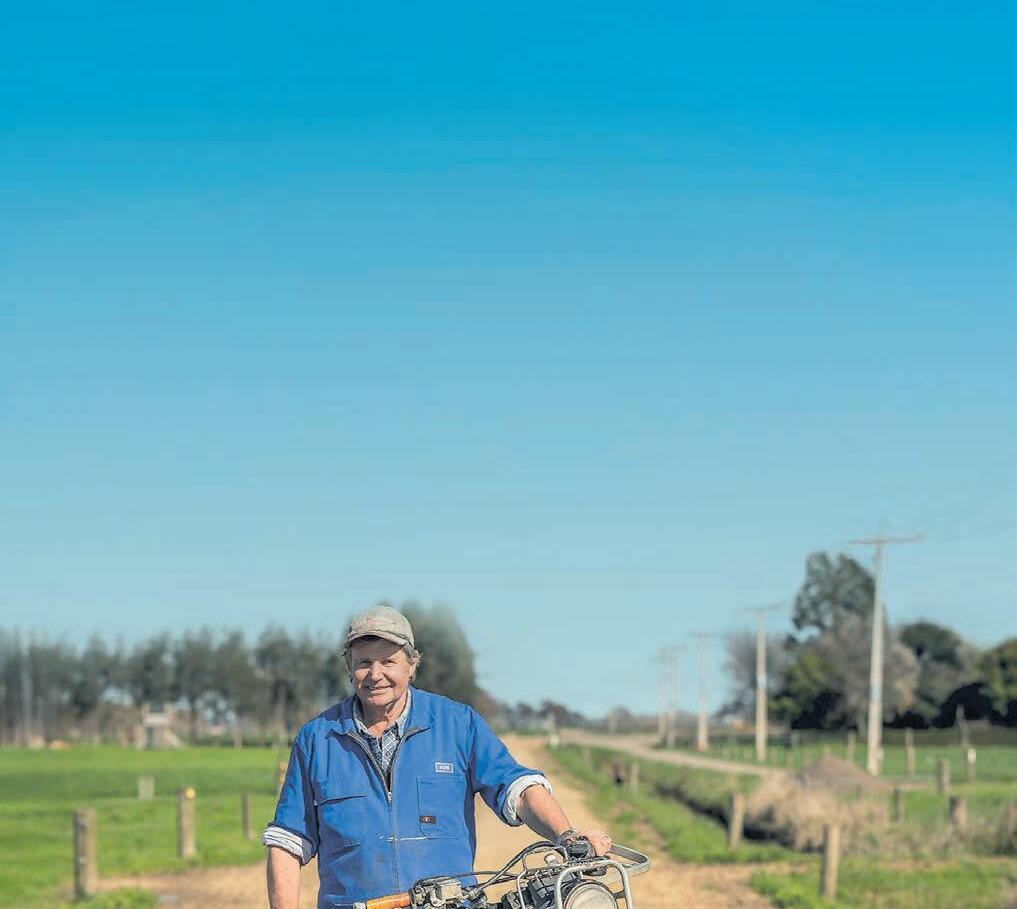

increased isolation online purchasing brings.
alternative payment methods like AfterPay, and risking getting trapped in payment cycles from them.”
She also agreed with the survey’s findings that Gen Z is tending towards buying local when it comes to food.
As concerns over social media’s impact on truth and reality grow, it is less trusted by consumers as a source.
Consumer engagement with search engines and social
platforms surged over covid. But despite that, consumers in US and Europe report that social media has the least influence on brand and product recommendations, with family and friends the greatest.
“I think this is also true for NZ consumers, they are quite sceptical about it. Things like greenwashing of products on these platforms do not align with Kiwi values of honesty, and issues over privacy protection.”
Cat-shaped hole in the Predator Free strategy

Gerhard Uys NEWS Pests
FERAL cats can spread diseases that impact farm production, and the animals also wreak havoc on native bird populations.
Predator Free NZ chief executive Jessi Morgan is urging farmers to support adding feral cats to the Predator Free 2050 target species list, alongside rats, possums and mustelids. Including feral cats in the strategy would lead to better policy decisions and greater investment in tools and technology for their control, Morgan said.
risen so sharply that farmers are taking notice.
This year, 80% of Predator Free NZ’s conversations at Fieldays centred on controlling them.
“Numbers are going through the roof. We are not 100% sure why that is, we don’t have the research to know.”
Feral cats spread toxoplasmosis, which causes early abortions in ewes.
While vaccination is common, it is not fully effective, and feral cat control should remain a priority, Morgan said.
when combined with rabbit, rat and mouse management to reduce food sources.
Unfortunately, areas with increased planting are becoming hotspots for feral cats.
“Cats are an apex predator in New Zealand. Nothing else is going to control them unless we do. By adding cats, we support local council management efforts.”
Morgan said feral cats are notoriously difficult to control. Live trapping, spotlighting and thermal or night-vision shooting are effective.



Feral cat numbers have
Coordinated efforts through catchment groups increase the likelihood of sustained control, especially
The New Zealand Veterinary Association Te Pae Kīrehe (NZVA) also backs feral cat control.



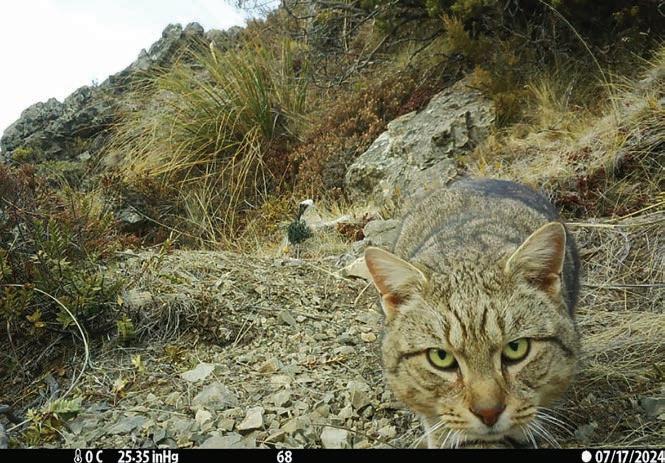
NZVA head of veterinary services for companion animals Dr Sally Cory said the association recognises that feral cats, while sentient, pose a serious threat to wildlife and spread diseases like toxoplasmosis.
“On balance, NZVA supports feral cats being managed as pests and their populations humanely reduced or eradicated as part of Predator Free 2050, provided this is done in accordance with bestpractice animal welfare standards,” Cory said.
ISOLATED: Dr Meike Rombach believes New Zealand consumers have not adapted as much as other nations to the
Photo: Pexels
DISEASE: Feral cats spread toxoplasmosis, which causes early abortions in ewes. Many farmers vaccinate sheep against the disease, but it is not 100% effective.
Scientists mourn loss of MethaneSAT

Neal Wallace TECHNOLOGY Emissions
LOSING a satellite has made this one of Sara Mikaloff-Fletcher’s more frustrating working weeks.
A principal scientist at NIWA, now Earth Sciences New Zealand, and leader of a project that used the international MethaneSAT satellite, Mikaloff-Fletcher was overseeing the NZ element of a project to measure global methane emission, including from dairy farming regions.
Last month controllers lost contact with the satellite, launched in March last year. It has now lost power and cannot be recovered.
NZ was a partner in the MethaneSAT mission along with the United States-based Environmental Defence Fund (EDF).
The satellite was primarily tasked with measuring methane emissions from oil and gas regions but also from agriculture, including NZ dairy regions.
Once or twice a month it passed over NZ and measured methane trends from Waikato and Canterbury and, if topography was proven not to be an issue, Taranaki and Southland.

We have great data and will be able to produce emission maps even from this limited period.
Sara Mikaloff-Fletcher NIWA
Mikaloff-Fletcher said it collected 97 agricultural scans, including 13 from NZ, from 200km square blocks, using precision technology with high spatial resolution.
Scientists are still to analyse the NZ data, but she said an initial assessment indicates it is consistent with predictions
from modelling along with data from ground and aircraft-based monitoring.
“Everything is lining up.
“We have great data and will be able to produce emission maps even from this limited period.”
Mikaloff-Fletcher stressed it was not a case of big brother spying on the agricultural sector, but rather of using a precision tool to monitor changes in methane emissions.
Even though the satellite is out of action, she said, a major benefit will be future collaboration with entities such as NASA and the European Space Agency.
“I see this as a growing area of research, collaboration and technology transfer opening the
door for NZ to partner in other areas.”
Andrew Johnson, deputy head of the New Zealand Space Agency, is disappointed the satellite has failed.
“As those who work in the space sector know, space is inherently challenging, and every attempt, successful or not, pushes the boundaries of what we know and what we’re capable of.”
He said NZ’s involvement reflects its commitment to advancing science, fostering innovation, and contributing to global knowledge.
The project had funding from the Ministry for Business, Innovation and Employment and RocketLab.
The University of Auckland’s Space
LOST IN SPACE:
Controllers lost contact with MethaneSAT, a satellite designed to measure global methane emissions including from New Zealand dairy farms.
Trusted by farmers for effective worm control with NIL MILK withholding periods and improved R.O.I
Studies in NZ dairy cows have shown the potent effects of EPRINEX® on parasites resulted in more daily milk, more milk protein and more milk solids.1,2

Institute was mission control for the satellite.
The EDF said the project has given insight into the distribution and volume of methane being released, especially from oil and gas production areas.
Advancing the capability to interpret measurements from space and translate them into volumes of methane released will be useful for other missions, the EDF said.
The advanced spectrometers developed specifically for MethaneSAT met or exceeded expectations, demonstratingthat the highly sensitive instrument could see total methane emissions at low levels and over wide areas.
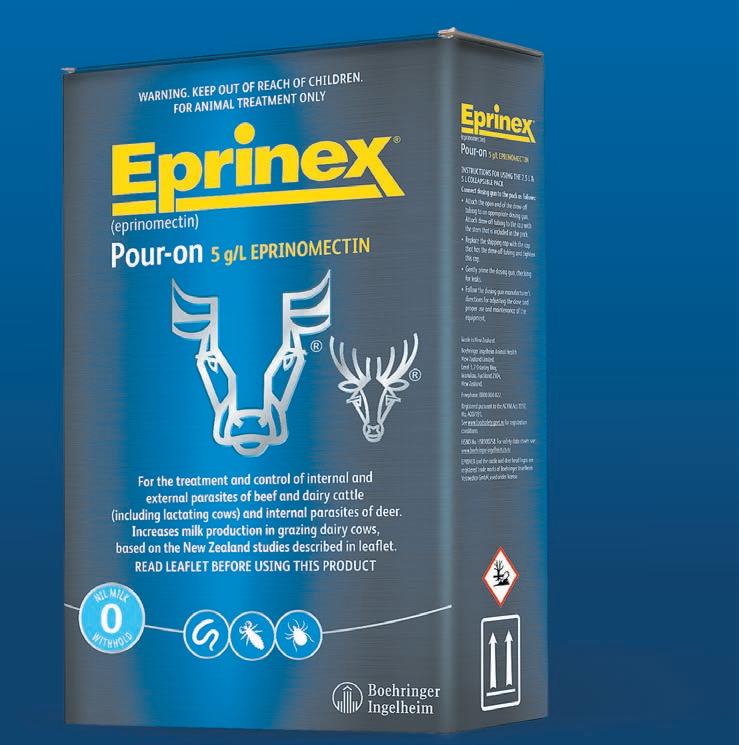

Antibiotic ‘trigger’ breakthrough at Otago

Neal Wallace NEWS Disease
ATEAM of scientists at the University of Otago have re-engineered antibiotics to activate only in the presence of infection, which will reduce the risk of resistance developing.
The overuse and misuse of antibiotics internationally in cattle, sheep, pigs, poultry, horticulture and marine farming is creating antimicrobial resistant bacteria that is being transferred to humans.
University of Otago researchers Professor Sarah Hook and Dr Allan Gamble have modified antibiotics so they activate only in diseased tissue.
Hook said antibiotic resistance is “a significant problem for farmers internationally and nationally and there will be more oversight in the use of antibiotics”.
Access could potentially become vet-only.
The World Health Organisation has identified antimicrobial resistance as one of the top 10 global health threats facing humanity, though it appears NZ farmers and growers are doing their bit. A Ministry for Primary Industries report last year found total sales of veterinary and horticultural antibiotics were down for a sixth successive year and sales of antibiotics considered critical for human health almost halved in the previous year.
Hook said the traditional response from farmers or growers when faced with a disease outbreak is to dose their whole herd or orchard with antibiotics, as happened with the PSA outbreak in kiwifruit.
This is designed to treat the disease and stop it spreading even
Gang-busting bull season finally draws to a close

Gerhard Uys MARKETS Livestock
BULL sales drew to a close last week with only five sales.
Seven Hills Angus, Pahiatua, sold 33 from 47, averaging $9500. They sold Lot 1 U13 for their highest price of $18,000 to a commercial grower.

of Otago scientists who have discovered how to reduce the risk of developing resistance to antibiotics.
If the animal is healthy, the drug will just float around and do nothing.
Prof Sara Hook University of Otago
though large numbers of stock or trees are healthy and do not need it.
The Otago researchers took what they called a “triggerable responsive antibiotic pro-drugs” approach and found a solution by re-engineering the drug to act only on the disease.
Hook said their solution had to be simple, cheap, scalable and used with existing antibiotic drugs, which they achieved after seven years’ research, including two interrupted by covid.
“If the animal is healthy, the drug will just float around and do nothing,” said Hook.
“And because it’s inactive, it won’t push the development of antibiotic resistance.
“The pro-drugs will only activate in the presence of infection.”
This means farmers can continue using antibiotics. The active antibiotics will be concentrated on treating disease or bacteria, and good bacteria – in or on healthy or infected animals – will not be harmed.
Because of this there is less chance of antibiotic resistance developing and reductions in the amount of active antibiotic ending up on pastures, in soil and in waterways.
Hook said antibiotic manufacturers are interested in their discovery but want more evidence of how it will work in the field.
A three-year grant from the Ministry for Business, Innovation and Employment will fund completion of research work this year. Animal trials will start with sheep next year, and be run on cattle in 2027.
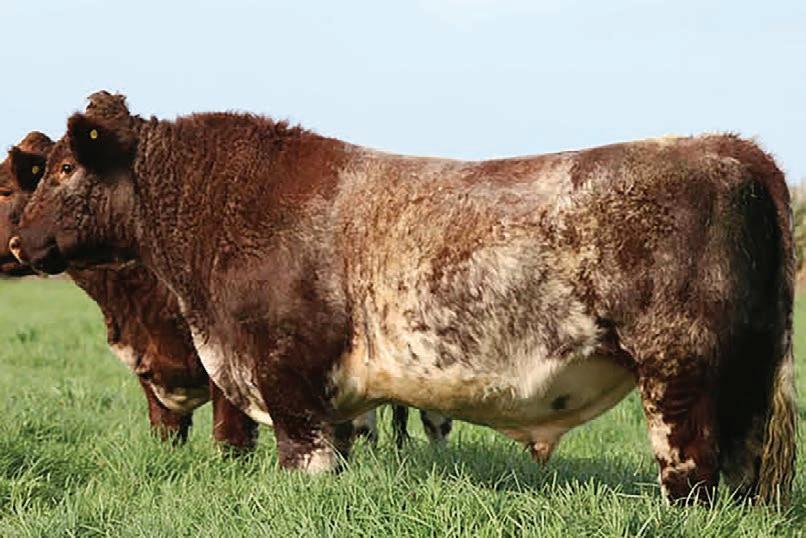
Matauri Angus, Dargaville, R2 dispersal sale saw 25 from 29 sold, averaging $8040, with a top price of $25,500 for Lot 4 Matauri Sound Reason U702 to Kincardine Angus. Glenrossie Beef Shorthorn, Whangarei Heads, and Santa Gertrudis Stud sold 10 from 16 of their Shorthorns, averaging $8270, and transferred Lot 1 Glenrossie Gold 23001 to Longview Shorthorns for $17,500, and Lot 9 to Glendhu for $11,000. Glenrossie also sold five from six Santa Gertrudis, averaging $5200 with a top price of $9000.
Gold 23001 to Longview Shorthorns for $17,500.
Turiroa Angus, Wairoa, cleared 49 bulls, averaging $16,897, with their highest price of $40,000 paid by Pine Park Angus, Marton.
A full season review will be published on July 14.
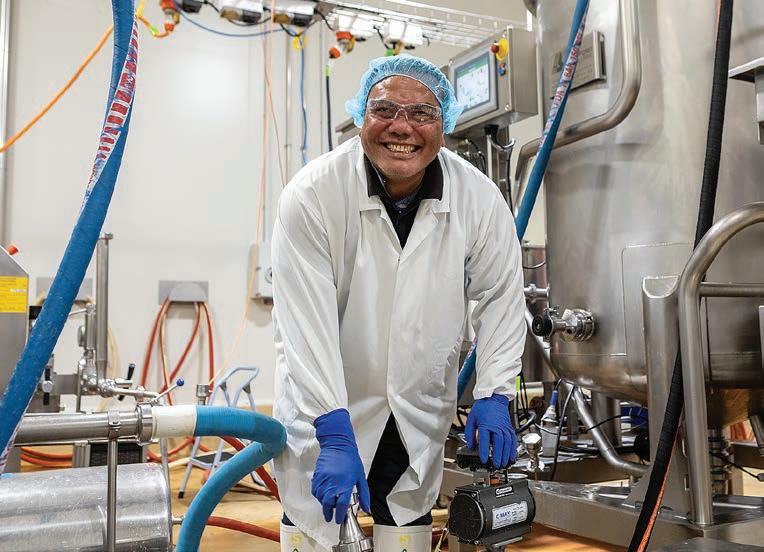
Waste tech offers a higher value option

fibre
A WASTE upcycling system developed in New Zealand is described as a game-changer for growers grappling with crop losses, slim margins and limited market options.
The tech turns low-value horticultural waste into highvalue ingredients, offering a fresh income stream and a path to greater food security.
Auckland-based venture Powered by Plants (PbP) has developed a modular biorefinery system capable of converting surplus and unsold fruit and vegetables into shelf-stable food powders, concentrates and extracts.
The innovation, supported by the New Zealand Food Innovation Network (NZFIN), also produces bioenergy, insect protein and organic fertilisers from otherwise unrecoverable waste.
PbP director Dr Andrew Prest said the idea was born out of frustration with the inefficiencies in New Zealand’s $7 billion horticulture sector, where up to 20% of produce is often discarded before sale.
“The fact we import onion powder while sending thousands of tonnes of local onions to landfill is absurd.
“Growers are stuck in a cycle of high inputs, narrow margins and limited options. We saw a need for something better.”
The onion industry alone sends around 22,000 tonnes to landfill every year, representing a lost value of $15 million annually. This comes before considering the missed opportunity to process that waste into a $3000-per-tonne food-grade product.
The PbP system can upcycle almost any horticultural crop from carrots and capsicums to kiwifruit and mushrooms. It is designed to work locally, close to where produce is grown, and at full scale aims to process around 8000t of surplus a year
from regional “spoke and hub” facilities.
Gisborne, Pukekohe and Hawke’s Bay are flagged as key locations.
Prest said the platform is fully circular, integrating black soldier fly farming to convert residual biomass into insect protein, with biogas and organic fertiliser production built in.
Renewable heat and power generated onsite can be used or fed into the grid.
The model’s IP is being protected as PbP looks to scale it internationally, targeting countries across Asia-Pacific facing similar challenges around food waste and limited processing options.
The fact we import onion powder while sending thousands of tonnes of local onions to landfill is absurd.
Back home, Prest said demand from food manufacturers and service providers is growing, with many looking to secure locally sourced ingredients to reduce exposure to import volatility.
“New Zealand is close to maxing out its ability to produce more food by volume. The only way we increase value from here is by adding it. That starts by seeing ‘waste’ as a resource.”
Beyond the economic boost, Prest said the social impacts could be just as significant.
“If we can help growers pay better wages and offer year-round jobs in regional communities, that changes the outlook for a lot of people and helps keep fresh produce on the shelf at a price Kiwis can afford.
“We’ve proven the model works. What we need now is the capital to scale it and unlock a solution that benefits growers, processors and communities alike.”
CUTTING EDGE: Researchers Allan Gamble and Sara Hook are among a group of University
Richard Rennie NEWS Food and
Dr Andrew Prest Powered by Plants
WANT NOT: Powered by Plants director Dr Andrew Prest says the company’s tech can divert thousands of tonnes of valuable food waste from landfills, creating energy, jobs and protein.
GOLD: Glenrossie Beef Shorthorn and Santa Gertrudis Stud sold 10 from 16 of their Shorthorns, averaging $8270, and transferred Lot 1 Glenrossie
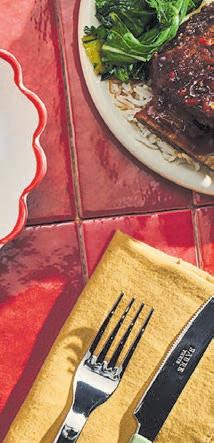

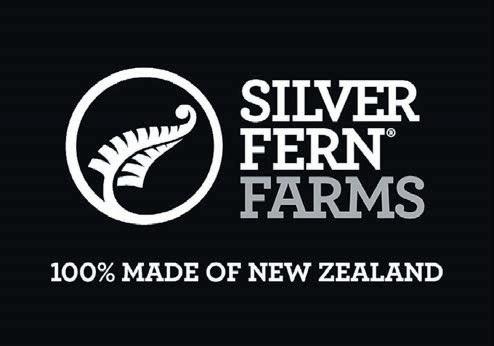
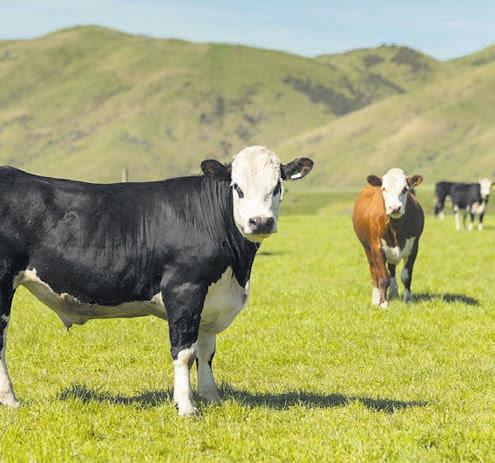


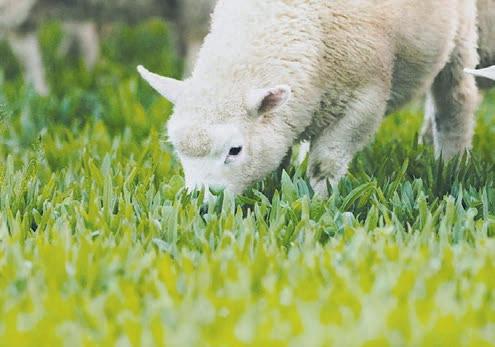




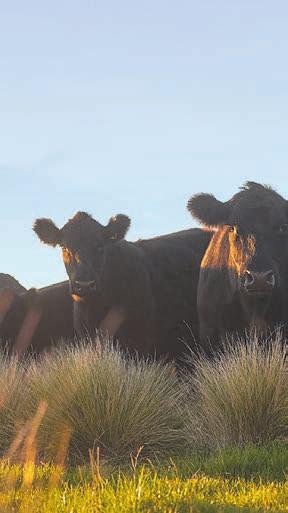

WHY
ATTEND FARMER CONFERENCE?
{ Get off farm
{ Re-focus and get inspired for the season ahead
{ Network and meet like-minded farmers
{ Hear from industry leaders and experts
{ Learn more about your processor
{ Enjoy our trademark hospitality
{ Shape the future of the red meat industry Join us. Our conference is free to attend for all suppliers, shareholders and teams.

Science head sees old problems in new model

Richard Rennie NEWS Research
A“SUPERMARKETlike duopoly” is the prediction of a science leader for the prospects facing New Zealand’s primary sector under science reforms which began on July 1.
From this date four Crown Research Institutes (CRIs) were folded into the Institute of Bioeconomy Science under the government’s wide-ranging changes. It puts AgResearch, Plant & Food Research, Scion and Manaaki Whenua-Landcare Research all under one identity as one of four Public Research Organisations (PRO)s.
But Troy Baisden, co-president of the NZ Association of Scientists, continues to hold serious misgivings over the formation of the three big PROs –bioeconomy, earth sciences and health-forensic science. A fourth PRO will be focused on advanced tech and artificial intelligence.
“Several big questions remain over where this will really take science in NZ. When you look at the statements of core purpose for these new organisations, they are not greatly changed from what the CRIs had. That is, to be commercially focused.”
He said he had hoped to see a definitive shift in the intent of the new PROS, to broader “NZ Inc” research, with benefits that accrue nationally rather than to the bottom lines of entities. He sees little evidence this won’t happen under the new model.
“It’s just like instead of CRIs competing, we now have just two big entities, the Bioeconomy Institute and Earth Sciences, covering areas affecting the primary sector.

DUOPOLY: Troy Baisden, copresident of the NZ Association of Scientists, says there does not appear to be any real shift in focus for new PROs, with a commercial focus remaining and risking even more intense scrambling for limited funds.
When you look at the statements of core purpose for these new organisations, they are not greatly changed from what the CRIs had.
Troy Baisden NZ Association of Scientists
“Just putting a “P” into their description does not mean they will necessarily perform any differently.”
He is concerned that he sees no drivers or guardrails in place that will reinforce their role to provide more public good research. He sees no means to compel these two far larger organisations to share any IP their work develops with the rest of the country in a public sense.
Given NZ required $300 million in added investment just to get science spend back to 2019 levels in real terms, he believed two large entities would simply deepen the “funds scramble” that CRIs have endured for years.
He said years of funding erosion have scoured out NZ’s competitiveness and put the primary sector in a particularly vulnerable position. Estimates are that every dollar cut out of science spend is a $5-$20 loss of economic gain into the future.
His estimate is NZ needs to have about $500m invested into science to regain any internationally comparable equilibrium.
Job losses vary between the minister’s claim of 150 scientists losing positions, and the Science Association’s estimate of 600 job losses.
Baisden noted that the report Professor Peter Gluckman has done of universities’ role in science has not been made public yet.
“We can only hope this is an indication they [the government] are just going to let universities get on with what they are doing.”
Mark Piper, the transition CEO for the Bioeconomy Science Institute, has described its formation as an exciting opportunity for a sector facing challenges from climate change, land pressure and food demand.
“By bringing together more than 1500 researchers into one organisation we can better support the future growth and resilience of the bioeconomy, while maintaining a healthy environment,” he said.
The Bioeconomy Science Institute will be New Zealand’s largest research institute, supporting sectors contributing 80% of the nation’s exports and more than 10% of GDP.
Costs lift break-even forecast milk price
Staff reporter NEWS Dairy
AN INCREASE in on-farm costs has pushed DairyNZ’s Econ Tracker forecast break-even milk price for the new dairy season from $8.41 to $8.68/kg MS. These expenses include higher tax obligations due to higher returns and increases in general farm working expenses –particularly in feed, fertiliser and energy costs, DairyNZ head of economics Mark Storey said. This has pushed the breakeven milk price forecast up 27 cents. DairyNZ defines this as the milk sale price per kilogram of milksolids to cover a farm’s costs in a season, excluding capital expenditure and principal repaid on loans.
The Econ Tracker’s new predicted average payout sits at $10.21/kg MS and average
farm working sits at $5.84/kg MS.
Despite the elevated costs, the outlook for the 2025-2026 season remains positive, with robust milk price forecasts, and farmers likely to benefit from reduced debt levels and easing interest rates, he said.
“These conditions should support continued debt reduction, reinvestment on farm, and adjustments to personal drawings to manage inflationary pressures.”
However, the scale of cost increases over the past 12 months is concerning, and global volatility adds uncertainty to the months ahead.
Fertiliser prices have increased sharply due to global supply constraints, export restrictions from China, and increased natural gas prices. Compared to May last year, phosphate prices are up 34% and urea 40%.
Crude oil prices have also recently surged by 17%, due to instability in the Middle East.

Mark Ross of
Hope of regrowth in India as timber export destination

Richard Rennie MARKETS Timber
HOPES are high that India can return to its status as one of New Zealand’s top five timber export destinations as demand for logs there starts to gather pace.
As recently as 2019, India accounted for $243 million of annual log exports totalling 1.7 million cubic metres. That put it among this country’s top five export destinations, ahead of South Korea’s $145m, but well back on China, our No 1 market, totalling about 19 million cubic metres.
While prices may ease, the recent spike underscores ongoing energy market volatility.
“Given New Zealand’s reliance on imported fuel, dairy farmers should allow for potential cost spikes, especially during peak operational periods.
Given New Zealand’s reliance on imported fuel, dairy farmers should allow for potential cost spikes, especially during peak operational periods.
Mark Storey DairyNZ
“Feed costs have additionally climbed, with most commodities increasing between 6% and 37% per tonne over the past year. Palm kernel is the exception, with prices slightly down on last year.”
However, the 2019 peak quickly declined when regulations limiting the use of the fumigant methyl-bromide came into effect, banned for use in ship’s holds and effectively killing the trade there.
Trade in timber products fell to $9.5m in 2023 but has since lifted to $77m so far this year, with shipments resuming subject to methyl-bromide being used on arrival in India.
Pulp exports have also more than doubled from $20m to $45.6m.
Wood Processors and Manufacturers Association of NZ (WPMA) CEO Mark Ross said while logs are starting to rebuild, it is still a tough road for processors with finished wood products to sell in India.
“There are assorted nontariff trade barriers and tariffs. We face tariffs up to 30% on finished products, similar to what we have faced in China.
“We are hoping this will be something that can be resolved as we would really like to target more high-value exports there.”
Tariffs on logs amount to 5%.
AgriHQ analyst Reece Brick said industry estimates are that free trade in timber products and logs could add about US$7 per cubic metre to the trade. Based on the 2019 peak this could amount to almost an additional NZ$10m-plus to exporters.
“India has always been a very useful market to help buffer us against the volatility of the Chinese market. The loss of tariffs would help us be more competitive with the likes of Australia and Uruguay as exporters.”
Forestry, Trade and Investment Minister Todd McClay has announced forestry-specific trade missions to India in coming months as part of NZ’s wider free trade discussions with India.
The inbound visit, supported by industry partners, will showcase New Zealand forestry systems and sustainable management practices.
McClay said NZ’s relationship with India is a priority with forestry part of that.
“The goal is clear to grow the market, remove barriers and drive better returns back to NZ’s foresters and processors.”
Ross said India faces limited domestic supplies for timber but has the ability to source products from other global players that face significantly lower tariff rates.
GROWING:
WPMA is hopeful timber trade to India can be grown as tariff barriers are addressed.
Milk collections highest on record

Gerald Piddock NEWS Dairy
THE dairy industry had a record-breaking May after the latest production data shows total milk collections were the highest of any year on record.
NZX production data showed milk production was up 8% compared to May 2024, with 104,120,000kg milksolids produced.
“This is the highest May milksolids figure on record and up substantially from what the NZX milk production predictor midpoint had anticipated, which was a -0.1% year on year decrease,” NZX dairy analyst Rosalind Crickett said. It brought the total season figure to a 3% increase on the previous 2023/2024 season.
The May 2025 figure is also 5.4% above the rolling average, which came in at 98.759 million kg MS. On a tonnage basis, the figure is up 8.3% year on year with 993,000T of milk produced –another May record.
The total season figure is a 2.3% improvement on the previous 2023-24 season. Looking at the five-year rolling average of 955,000t, the May 2025 figure is 4% above that, Crickett said.
May was a wet, warm month for the country which saw NZX’s pasture growth index (PGI) –a measure of pasture growth potential – up 12% for the month compared to a year ago.
“It is also worth noting that the higher Fonterra payout has provided a key incentive for farmers to milk for longer, which could well flow into the June production figures,” Crickett said.
For Fonterra, its milk collection hit a five-year high with the cooperative’s final tally for the 2024-2025 season at 1.509 billion kilograms of milksolids.
This is a 2.6% lift compared to the 2023-2024 season where 1.47 billion kg MS was collected, according to data from Fonterra’s latest Global Dairy Update.
It is the highest volume of milksolids Fonterra has collected since the 2020/2021 season.
In the North Island, collections were up 2.8% from 832m kg MS to 855.7m kg MS.
South Island milk collections were also up, lifting 2.3% from 638.9m kg MS to finish at 653.4m kg MS.
Its total New Zealand collections for May were the highest of any year on record, up 7.5% to total 77m kg MS.
In the North Island, collections for the month were up 2.6% to total 36.4m kg MS. In the South
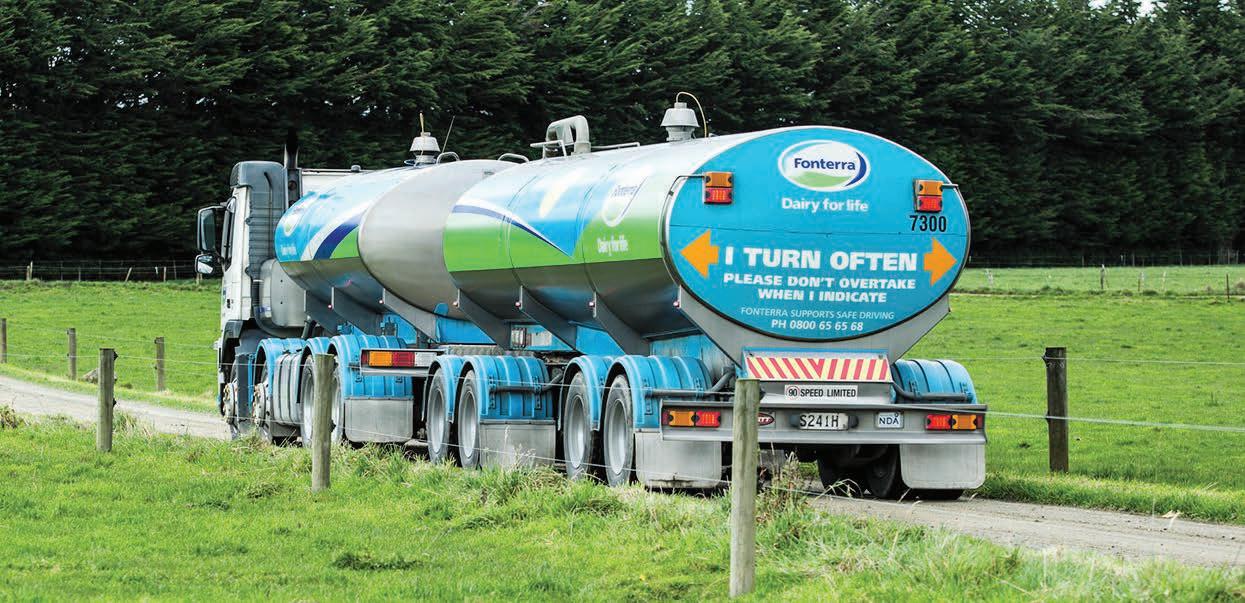
good news for farmers and NZ.
The higher milk collection is thanks in large part to favourable weather conditions across most of the country, which has supported pasture growth.
Anne Douglas Fonterra Farm Source
Island, collections jumped 12.3% to 40.6m kg MS.
Fonterra Farm Source group director Anne Douglas said it was
“Fonterra’s current forecast of $10/kg MS for the 2024/25 season equates to around $15 billion into the New Zealand economy through milk price payments alone.”
The majority of this flows into regional NZ, with farmers spending almost 50 cents of every dollar they earn in their local communities, she said.
“The higher milk collection compared to recent seasons is thanks in large part to favourable weather conditions across most of the country, which has supported pasture growth.
“There have been notable exceptions, including dry conditions earlier this year that made things really challenging for some of our farmers.”
Farmers are also getting more milksolids from every cow through breeding improvements and high animal welfare standards.
“The efficiency gains farmers are making is something they can be really proud of, and at Fonterra we’re focused on working alongside our farmer shareholders to help them be even more productive and profitable into the future.”














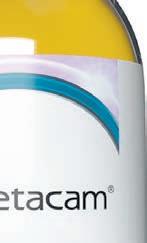









SEASON: Fonterra had the highest milk collection in five years in the 2024-2025 season.

Thank You.
A big thank you to all those involved in the inaugural Rural Leaders Dinner, Debate and Auction held in conjunction with Fieldays® & Event Par tners With over $300,000 raised for the benefit of Rural Suppor t Trust , the evening was a huge success.
Fieldays® remains commit ted to the rural communit y and aims to make this a regular event on the Fieldays® calendar

RUR AL SUPPOR T FOUNDATION PAR TNE RS E VE NT PAR TNE RS
F o u n d a t i o n Tr u s t

‘Empty nester’ takes lad under his wing
FROM fixing farm fencing to fishing in open water, 12-year-old Kobi is experiencing life beyond anything he has previously known.
And it’s because his life changed immeasurably when he met Mark Withers, who is a volunteer at Big Buddy.
“I was really nervous at first. I was, like, who is this guy?” Kobi said.
Withers is a former chartered accountant whose own sons have left home for university.
“I’d found myself an empty nester thinking, ‘What can I do to contribute to somebody else’s upbringing?’ Big Buddy was the obvious choice,” Withers said.
Big Buddy is a programme that matches boys aged seven to 17 who do not have a father in their lives with good guys from the community, Big Buddies, who volunteer their time.
It offers friendship, support and a good male role model to look up to.
Hibiscus Coast-based Withers decided he was willing and able to spare one hour each week to help another boy on his way in life.
“It took a while to go through
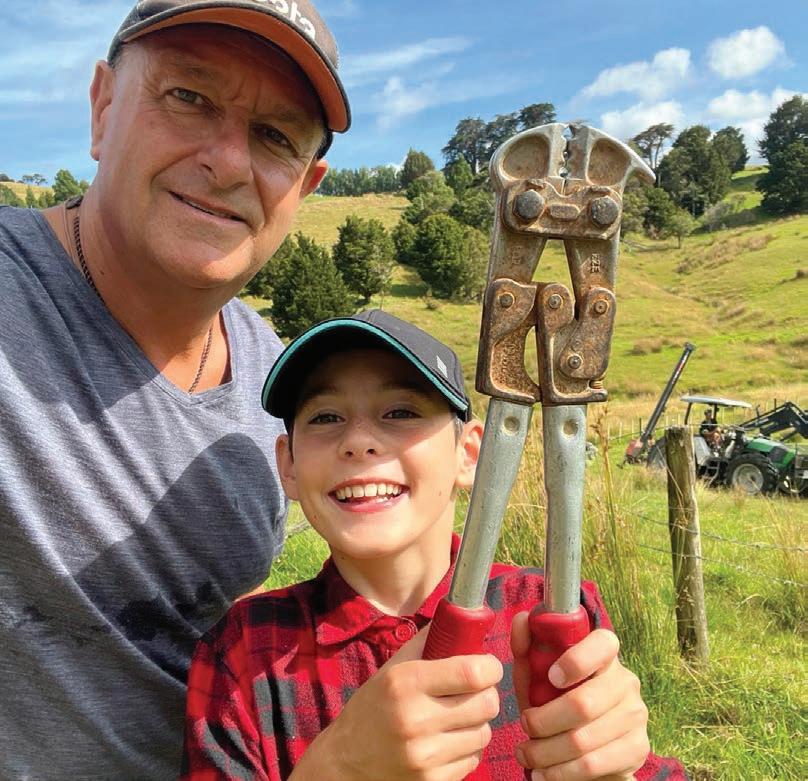
the process of being vetted and accepted. When we finally matched, we were both very excited.
“After all the anticipation, that was a big deal.”
Taking Kobi to his family farm in Kaipara has become a firm favourite.
“I’ve just come back from a day doing jobs on the farm,” Kobi said.
“I was in the pen, picking up lambs – I reckon I lifted about 400 times my body weight today,” he said.
He also learnt to fix fences, drive an ATV and how to use a firearm.
Kobi sees Army Cadets in his
AI informs precision fertiliser application

Neal
Wallace TECHNOLOGY Fertiliser
A PILOT programme across 18 farms will trial the latest version of Ravensdown Fertiliser’s nutrient management programme, Hawkeye Pro.
The new programme uses artificial intelligence, decades of soil data, and mapping software to create detailed maps of soil nutrient levels across an entire farm to allow variable rates of
fertiliser to be applied in a single pass by an aircraft or truck.
Mike White, the head of product and service development at Ravensdown, said it uses data already in the system, including previous soil tests, topography and proximity to sensitive areas to predict soil nutrient levels down to 10m x 10m resolution for sheep and beef farms.
Artificial intelligence leverages existing information about soil fertility to provide a detailed picture of fertility.
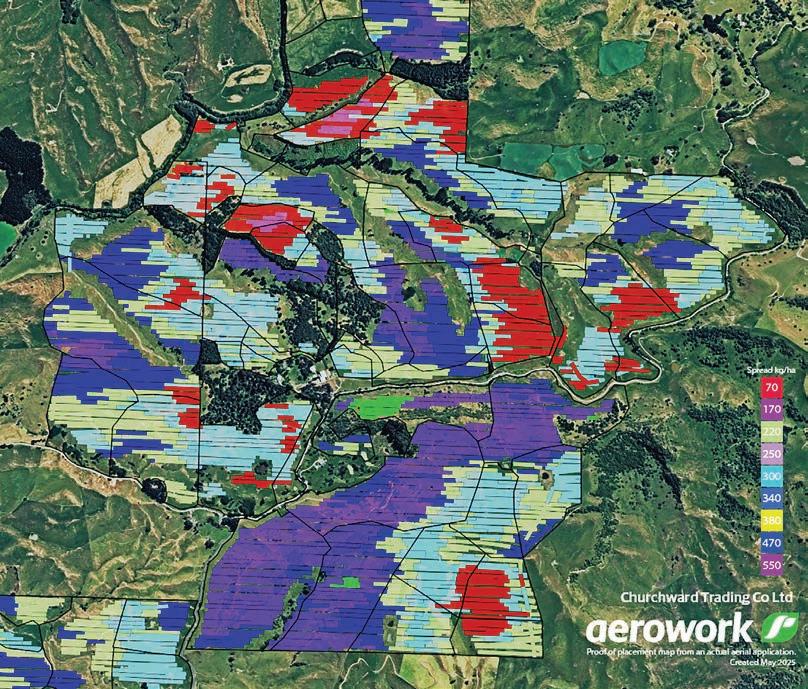
future, and his farm visits have seen him develop a love for the land, prompting a possible farming profession path.
Getting together was daunting for both Withers and Kobi, but it did not take long for them to bond.
Kobi’s mother Jody described it as an “emotional rollercoaster” in the beginning.
Jody has raised her son – and elder daughter Zali – single handedly following an abusive partnership prior to Kobi’s birth.
“When Mark came round for the very first time, we were so excited but also worried that this could be very awkward.”
Withers said it became clear very quickly that “we were going to get along.”
“All I could hear was chat, chat, chat and the two of them laughing – I knew this was a good sign,”
Jody said.
The pair haven’t stopped chatting since, and laughter is never far away.
At first, however, things didn’t go as planned. Unexpected hip surgery forced an otherwise active Withers into hospital for an extended stay.
“I knew Kobi was a very active kid, and I’d said I was an active guy when looking for a Little Buddy match, which I usually am.
“But when I contracted an infection in my hip replacement, I was suddenly stuck in a hospital bed. It was quite a different offering to what I’d advertised! So, that was quite challenging to get my head around at first.”
Jody brought Kobi to visit his new buddy, undeterred by the change of circumstances.
“Kobi was keen to go and visit Mark, eat his grapes, have a chat and take him some magazines to read,” she said.
“The real experience of being a Big Buddy has more than exceeded my expectations,” Withers said.
“And it’s not all about the big things; it’s often little things like just sharing a laugh, that add up. Kobi is so appreciative of everything we do, and he’s so enthusiastic – up for giving anything a go. He’s got such a lot of energy and that’s so good to be around.”
“It’s always super fun,” Kobi said.
“And if there’s something new to learn, it might be hard at first, but I know I can do it. Mark’s taught me how to do so many things. He gives me a hand then I’m off – there’s no stopping me.”
MORE: Big Buddy has 100 boys waiting for Big Buddies overall, and the average waiting time is nine months. www.bigbuddy.org. nz/buddy-up/become-a-big-buddy/
“Soil fertility maps are just the beginning of the nutrient planning process and Hawkeye Pro leverages the knowledge gained from decades of NZ-based soil and fertiliser research to produce specific fertiliser plans tailored to each farm,” said White.
This is uploaded to aerial and ground spreader computer tracking systems, which enables variable rates of fertiliser to be programmed and applied in one pass.
“It recognises areas that are high producing, so need more fertiliser, and those that are low producing and need less,” said White.
The programme provides automated data for NZFAP audits.
Ravensdown has been working on variable rate application for more than a decade.
It then became aligned with the Ministry for Primary Industries Pioneering to Precision initiative, which received Primary Growth Partnership support.
Trials have shown cost savings of $50 to $150/ha through efficient placement, rate selection of fertiliser and a subsequent increase in land productivity.
The pilot programme, on 13 dairy farms across both islands, and five sheep and beef operations in North Island hill country, aims to ensure the enhanced fertiliser plans are practical and usable.
Aerowork chief pilot Mark Tocher describes the variable rate

Gone are the days when you open the hopper and apply a blanket rate.
Mark Tocher Aerowork
technology as “a game changer”, and something the two entities have been working towards for some time.
Tocher said pilots will have to be more vigilant to ensure fertiliser is flowing and at correct rates.
“Gone are the days when you open the hopper and apply a blanket rate.”
Tocher said Aerowork pilots were involved in testing and trials. The technology is in the process of being installed in the company’s 10 aircraft, a process that requires Civil Aviation Authority approval.
An early limited release for sheep and beef farming is set for September 2025. The tool will be available for dairy farmers from autumn 2026 and will be available for the arable sector as new functionality drops during 2026.
DETAIL: A Hawkeye Pro application map for a farm. Soil fertility maps are just the beginning of the nutrient planning process, says Ravensdown’s Mike White.
EYE IN THE SKY: Aerowork chief pilot Mark Tocher says pilots will have to be more vigilant to ensure fertiliser is flowing and at correct rates.
LEARNING: Big Buddy volunteer Mark Withers has been teaching 12-year-old Kobi farm skills on his Kaipara family farm.
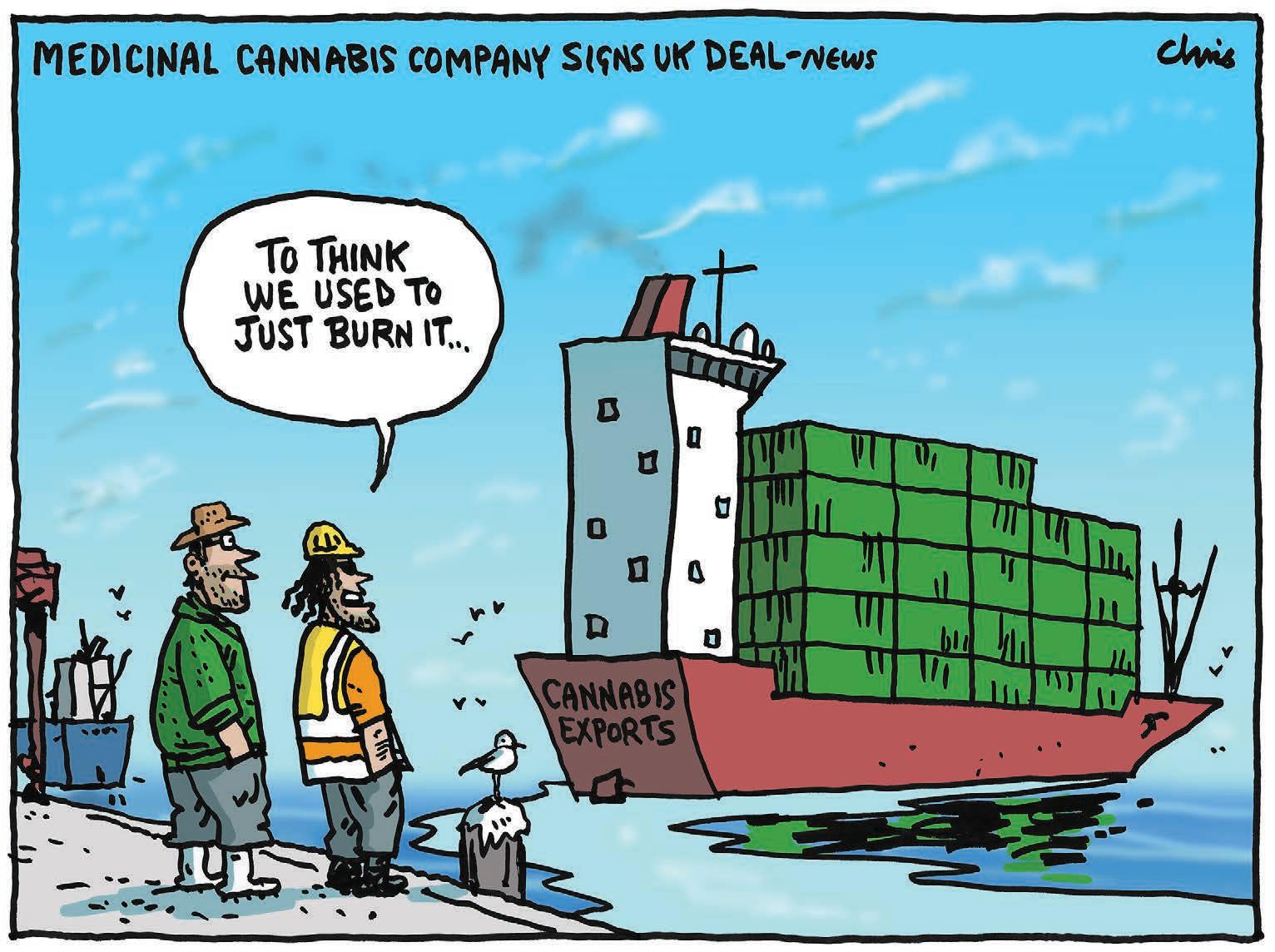
From the Editor
Closing the books on a great dairy season

TGerald Piddock Senior reporter
HE past few months have been a great run for the dairy sector. After receiving confirmation of another bumper milk price forecast in late May, the latest production data marks off what has been a pretty remarkable season for the dairy industry.
It’s been the highest production season in five years with Fonterra’s milk collections for the season just finished totalling 1.509 billion kilograms of milk solids, a 2.6% lift on the previous season.
May’s production data also hit a record, up 7.5% to total 77 million kg MS.
Likewise, NZX’s own data painted a similar story, up 8% compared to May 2024 with 104,120,000kg MS produced.
It’s been a pretty rapid turnaround after it was not that long ago that much of the North Island was in the grip of a devastating drought.
Then at Fieldays, contributing to the positive vibes, the government’s latest Situation and Outlook for the Primary Industries showed dairy export volumes lifting 16% to reach $27 billion. Combined with the other primary industries, the sector was forecasting a record revenue of $59.9bn by June 30.
The primary sector was expected to reach $65.9bn by 2029, of which, dairy would contribute $30bn.
It’s no exaggeration to say that the industry as a whole is what is keeping the national economy’s lights on at the moment.
The current $10/kg MS forecast for the new season equates to around $15bn to the economy and that’s just the milk price payments.
There was some deserved discretionary spending at Fieldays, going by anecdotal feedback at the four-day event.
Dairy farmers know that these prices are cyclical and have used the extra cash to pay off debt with it sitting around $35bn – the lowest it has been since 2018.
While interest rates have fallen, they will also be conscious that their expenses are still high-ish, as noted in the latest DairyNZ Econ-Tracker update.
Lifts in the big three – feed, fertiliser and energy – as well as higher taxes pushed up their forecast break-even milk price from $8.41 to $8.68/kg MS.
LAST WEEK’S POLL RESULT
EIGHTY percent of voters believe the government should be showing more urgency with its changes to the Environmental Protection Authority.
This week’s poll question (see page 1):
Is it still relevant for a meat company to operate as a 100% farmer owned co-operative?
“We are losing capability and potential options for crop management,” one said.
“The lack of action by the government is a huge concern.
Despite all the rhetoric there has been no changes, the rate of approval of innovative products is no better,” said another.
One voter said when a big
It is still well below its predicted average payouts of $10.21/kg MS.
The latest GDT result is down 4.1%, but at such an early stage in the season it is too soon to say that the worm is turning.
NZX has noted its timing, being right in the middle of peak production in the northern hemisphere and the first auction of the season where Fonterra has seriously added some volumes.
Dairy farmers know that these prices are cyclical and have used the extra cash to pay off debt.
Hopefully farmers got to have some sort of decent break over the past month so they can recharge their batteries with another year of calving set to get underway shortly in the North Island.
It looks like they are facing those evergreen winter farming issues – managing wet paddocks to protect pastures ahead of spring while at the same time trying to reach those cow body condition score targets for their animals by making sure the animals are properly fed.
And the clear daylight between those costs and the forecast income should definitely ease the stress of the long days that can occur during calving.
company like Bayer says it isn’t worth its time considering NZ for any more new actives, it’s clear that whatever changes are in progress are not being implemented urgently enough.
Of the 20% who voted no, one said “the EPA is the agency that considers all benefits and adverse effects in a scientifically measured way. Any speed to remove these protection, like the Gene Technology Bill is signalling, is going to directly impact badly on farmers and the rural sector”.
Letters of the week Common issues, common sense
Shelley Dew-Hopkins Manawatū River Catchment Collective
THE suggestion that catchment collectives are simply large entities chasing efficiency misses the mark.
Groups like the Manawatū River Catchment Collective (MRCC) represent a fundamentally different model – one grounded in community, collaboration and practical action.
These locally driven initiatives are some of the quickest and most effective ways to support environmental improvement while enabling sustainable land use. Rather than waiting for top-down regulation, catchment groups work from the ground up to drive practice change – in a way that makes sense for their landscape, their farming systems and their people.
Catchment collectives are also incredibly efficient when it comes to environmental data collection. Councils and government agencies spend significant sums on this, but farmer-led groups can often collect the same data with greater local context and at a fraction of the cost.
Importantly, we must also recognise the unfair burden placed on conscientious landowners who are already paying for robust environmental plans. If these plans benefit the wider community – and they do – then farmers shouldn’t be expected to carry the full cost alone. Collectives help reduce this cost and make planning more accessible, and they should be supported to continue doing so.
Finally, working with farmers – not against them – is key. If landowners can show improvement over time, we should empower them to lead that journey. Water doesn’t respect farm boundaries; that’s why catchment-wide solutions are vital. Collectives like MRCC aren’t just efficient – they’re effective, trusted, and capable of delivering the long-term change our regions need.
Ongoing support for catchment groups isn’t just good policy – it’s common sense.

Last week’s question: Should the government be showing more urgency with its changes to the Environmental Protection Authority?
C words: choose them with great care
Eating the elephant

Phil Weir Weir is an associate trustee of AGMARDT and a Beef + Lamb New Zealand farmer-elected director
SCHOOL holidays are a great chance to usher in the next generation of farmers. At our place there is plenty of help with the routine jobs, from three of my own to cousins converging to “help out”.
Farmers know that many jobs can lead to colourful language. Our youngest dropped what she was carrying into a muddy puddle. Rather than stringing together a long list of expletives she, with significant rage, shouted, “Argh, biscuits!”
I was impressed. There was the natural rage at the mistake, but the words chosen were altogether more suitable. I have a tendency to use a C word too much and school holidays remind us that language
is important and so too are the ears of the next generation who hear it. It also prompted me to think about the large number of C words in constant use.
Words carry weight. They shape how we see a problem, frame a debate, and seal a commitment.
When “climate change” features in strategy sessions in boardrooms of global buyers, that’s fair enough; on farm, we feel its floods and droughts firsthand.
But when “collaboration” becomes the sector’s go-to metric for progress – measured in meetings attended or cappuccinos shared – we need to ask: are we shifting the dial, or simply admiring it?
“Collaboration” sounds warm and fuzzy –“let’s work together”. But in practice, it spans everything from borrowing a neighbour’s tractor to hammering out a 12-page joint venture.
If we want meaningful collaboration – on irrigation upgrades or marketing co-ops – we need more than nods over the gate. We need clarity on who invests, who owns what, how the revenue splits, and who’s fixing what when it all starts creaking. We also need to ask why we’re collaborating. Not because it’s the trendy thing to be seen doing, but because if we do it well it gets us building: more wind farms, more water storage, more solar, more produce on Chinese or Chicago shelves, more export earnings.
On top of the

IRECEIVED a real buzz from the recent Primary Industries Summit in Christchurch. There were more than 400 delegates from the primary sector and surprisingly, some might say, they were all looking in the same direction.
The speakers were impressive.
The conference, sponsored by Federated Farmers, Brightstar and Rabobank, was opened by Feds president Wayne Langford, who gave an extremely positive address. He portrayed the sector
But we need contracts rather than just collaborative coffees. These can be harder, but they are worth it.
A contract is just a written pact that lays out roles, milestones, financial commitments and exit clauses – everything you’d rather not negotiate on a wet Sunday morning.
Sure, some shy away, fearing it’ll make the family farm sound too “corporate”. But a contract doesn’t kill trust – it protects it. It gives confidence that when the drought breaks or the milk price wobbles, everyone knows their lane.
For most farmers, contracts are not our everyday. Often the ones we are most familiar with are resource consents (a type of contract with a regulator). Having started my career as an RMA planner in the early 2000s, I know how painful these can be, I know getting permission to prune a tree or run a few cattle is a nonsense, but if we positively reframe consents we can see that the administrative pain creates legal agreement, and this certainty has value.
So don’t confuse cafés for contracts. Unless you bind yourselves to shared rules, you’re just ordering another round, which is only fun in the short term.
All this talk circles back to the home farm – and the final C: change. Or more precisely, succession. According to Rabobank’s latest Changing of the Guard report, more than 17,000

WORDS MATTER: Choose your words, like your seed mix, intentionally, says Phil Weir. Let ‘collaboration’ come with contracts. Let ‘succession’ make room for ‘transition’ and keep our best people engaged, not anxious.
New Zealand farm operators will reach retirement age in the next decade. That’s an eye-watering $150 billion asset handover. But only 34% of farming families have a formal plan. Another 17% have talked about it, but written nothing down. The rest – 49% – haven’t even opened the conversation.
Imagine half of Aotearoa’s productive land changing hands with no roadmap. No governance framework. No milestones. No carve-outs. It’s like running on for a final with no game plan and a blindfold on.
And maybe that’s where language can help us again.
“Succession” sounds feudal –counts and duchesses passing down a title. “Transition” is a softer, more accurate term. It signals a phased handover of
leadership, stewardship and governance. It leaves space for shared roles, cross-generational partnerships, learning curves, and, yes, even mistakes.
Transition invites mentoring and measured milestones. It removes the need to crown a new monarch at sunset.
So here’s the pitch: choose your words like your seed mix –intentionally. Let “collaboration” come with contracts. Let “succession” make room for “transition.” and keep our best people engaged – not anxious. The right word, used well, is more than grammar. It’s strategy. And right now, rural New Zealand could use a little more of both, so let’s conclude with a final C word, courage, and get on with cultivating the coolest country on earth.
world after agri summit
as “one team”, which was music to my cynical ears. He spoke of making farming great again, which I support. I was pleased he didn’t talk of making agriculture great again – the MAGA connection would have done my head in.
Langford has really grown into the role and Feds today is a highly focused, strategically oriented organisation. In addition, membership is growing – which is surprising considering there are fewer farms than there used to be.
He was followed by Minister of Agriculture Todd McClay who, again, was extremely positive. He explained how the Chinese middle class is expected to grow to 500 million over the next few years, which creates a ready market for our food and fibre production.
He told the conference that leaving the Paris Accord would be madness and that the accord hadn’t harmed farming. He said taxing methane was “too blunt an instrument” and that he hoped to have realistic methane targets by Christmas. I’m looking forward to seeing the document.
Michael Every is the global strategist for Rabobank. His presentation, How is Trump 2.0 Changing Everything, was exceptional.
He described how the United States’ grand macro strategy involves unashamedly putting America first. He told us that in
today’s world, production is more important than profit and that downstream is more important than upstream.
Every pointed out that tariffs had worked for centuries and that Trump’s aim is “to freeze out China”. That the US “wants to isolate but control the world” and that the days of free trade and free defence are over.
He told the conference NZ is going to have to choose between the US and China, which I found singularly depressing.
Finally he told the conference that New Zealand is going to have to choose between the US and China, which I found singularly depressing.
Vangelis Vitalis is the deputy secretary, trade and economic at the Ministry of Foreign Affairs and Trade. He discussed the current conflict between China and the US and gave a sobering picture of what happens when you offend China. Australia had found out as when it offended its major market it lost access for its wine, barley and coal.
He explained how subsidies remain a threat, especially in the US and the European Union. Soberingly, he suggested the
current cost of subsidies, $850 billion over just four countries, is about to increase further. That subsidies are justified under the banner of self-sufficiency.
He also explained the effect of non-tariff barriers like packaging.
Vitalis’s presentation included a briefing on progress with the proposed free trade agreement with India. He seemed really positive about the outcome, which I found encouraging.
New Zealand agriculture, he explained, has a unique position in world trade of both safety and security.
Rabobank had an excellent presentation on succession, which I won’t go into detail about here.
Suffice to say if you’re long in the tooth, talk to Rabobank.
I hadn’t heard the Associate Minister of Agriculture, Nicola Grigg, speak before but she was certainly able to relate to her audience. She is obviously on top of her portfolio and handled difficult questions with ease.
She was followed by Ministry for Primary Industries directorgeneral Ray Smith, who was similarly impressive. He explained, in detail, how we were going to increase exports, speaking to the MPI vision that “New Zealand will be the world’s most trusted provider of high-quality food and fibre products”.
A highlight for me was Scottish
journalist and Nuffield scholar Claire Taylor, who talked of changing the image of NZ farming. What was reassuring was that our sector, finally in my opinion, was getting its act together. The issues are the same the world over. Uninformed detractors like Greenpeace and Safe casting uninformed barbs at the sector.
Clarkson’s Farm was hailed as a great showcase for the sector and I agree.
It was suggested on The Country that we could replicate Clarkson’s Farm here, using, among others, Mike Hosking and John Key.
While I have no issues with replicating Clarkson’s Farm I have major problems with the Hosking-Key scenario. I’d humbly suggest that we would want the programme to be taken seriously. I’d also suggest that our sector is more together today than it’s ever been and that we have great advocates in Langford, the board at Feds and Beef + Lamb NZ chair Kate Acland.
I left the conference with a real buzz. I felt well informed of the current issues, the problems and opportunities the sector has and options for going forward. I was also proud to be part of a sector that is pivotal to the wellbeing of our country.

Photo: Pexels
Sector Focus
Farming a guiding star for young shepherd
Staff reporter PEOPLE Agriculture
THE eldest of four children, Puhirere Tau spent much of his early life independently learning the ropes, be it at home, school and even teaching himself to read English by reading newspapers.
Having spent most of his schooling in the Far North Island learning through kura kaupapa (Māori speaking and customs schools), he found it hard to adjust when his parents separated and he moved to the east coast with his mother to go to high school.
“As a teenager I was sort of unguided. I wasn’t a troublesome
child, I just didn’t have any direction.
“One of the most difficult parts of my life was changing from a Māori school to mainstream. And I think the hard part has been remembering my whakapapa.”
He said keeping in touch with his grandparents, cousins and aunties in the Far North kept him sane and helped him remember his Māori values.
Before he turned to farming, Tau competed in New Zealand’s X Factor, and turned to a building apprenticeship, but none of it was sticking.
“I had no idea what I wanted to do after school. I literally went to school to play rugby, hang out with my mates and eat my lunch.
“I lost direction. My teenage years were a bit of a drift; I didn’t

really know where I was heading.”
His uncle offered him a junior shepherding role on Whāngārā Farms’ Pakarae Station when he was 20, and in his own words “it changed the trajectory of my life”.
The now 27-year-old is a head shepherd at Puatai Station in Tolaga Bay, Ngāpuhi, Ngati Porou – and was a finalist in the Ahuwhenua Young Māori Farmer Award.
I’m passionate about giving back – especially encouraging other young Māori who might feel lost or unsure, like I once did.
Puhirere Tau Tolaga Bay
At Puatai Station he runs 2000 bulls, 700 R2s and 500 R1s.
“That opportunity in farming changed everything. Straight away I knew I had a deep connection with the land and loved the animals and the lifestyle that came from that. It gave my first real sense of purpose.”
The purpose has led to working on three thriving farms, all under Maori ownership.
It also led to a family of his own. He has four children – Te Aukainga, Tawhiorangi, Atawhai and Purirere Love Tau – with partner Lee-Jay Love.
Māori represent a significant and growing part – nearly 40% – of New Zealand’s meat processing workforce. More than 15% of sheep and beef exports come from Māori farming interests.
Tau said while being a Māori farmer makes him no better,
&

different or otherwise, there are some Māori values from his schooling and whakapapa that have deeply connected him with the land.
“A lot of the Māori values transfer into farming, such as kaitiakitanga – guardianship of the land and the environment.
“Why I progressed into farming so well was because I was taught kaitiakitanga. We were always taught to look after the land. I think that is why I connect so closely to farming.
“Farming is simple and common sense and having integrity and taking care of the land and animals.”
Tau said while he felt misguided as a young boy, his mother had a large family to cope with and was on her own.
“I didn’t have anyone to guide
me, I had to make my own way. I stayed with Mum and I had young siblings, but Mum didn’t have much time. In terms of making my way to sport, I had to find my own way. It taught me how to be independent.”
Tau hopes to complete a degree in agriculture commerce and own his own farm when the time comes. He’s grateful to be bringing up his children, all under eight years of age, on a farm.
“It’s been a journey of learning, growth, resilience and rediscovery of who I am and where I come from.
“Now I’m passionate about giving back – especially encouraging other young Māori who might feel lost or unsure, like I once did. If my story can help someone see their own potential, then it’s all worth it.”
Devold rolls out Sheep to Shop education programme

Annette Scott NEWS Food & fibre
DEVOLD New Zealand is rolling out a staged education programme aimed at building skills, strengthening succession and reinforcing animal welfare and product quality throughout the supply chain.
The Sheep to Shop Educational Programme (SSEP) has been codeveloped with wool growers and shearing teams across the South Island.
The programme is practical and peer-led, with input from experienced growers, breeders and shearers.
The year-long, fully funded SSEP features four regional modules covering genetics, nutrition, animal welfare, climate adaptation, safe handling,
shearing and workplace safety.
Health and safety modules will be added in 2026.
It has attracted 83 participants to workshops in Marlborough, Canterbury, Mackenzie-Waitaki and Central Otago. Devold NZ general manager Craig Smith said the response was positive across all regions, with particularly strong engagement and input from younger growers.
“The Devold supply chain is like no other. We have taken full responsibility from the sheep right through to the finished garment.
“Our growers share our commitment to quality and this new education programme gives everyone involved the chance to keep learning, apply the latest knowledge, and continue producing wool to the highest standard.
“It is also about encouraging and
supporting the next generation in our industry.”
The Module 2 session is all about communication in the woolshed and breaking down barriers between growers, wool teams and brands where no one person is more important than the other.
“We will be doing shed prep, wool prep and Devold wool requirements and making sure everyone understands how we all need to work together.”
Devold chief sustainability officer Trude Ertresvåg said the sector’s future depends on valuing those at its core.
“Devold sees the SSEP as a longterm investment in the resilience and quality of NZ’s wool sector.
“Addressing the real pressures facing growers requires more than compliance. It calls for honest collaboration across the supply chain.”

HANDS ON: Mark Urquhart, Craig Smith, Simon Paterson and Alan Paterson take responsibility for the wool from the farm to the shop.
FAMILY: Puhirere Tau with partner Lee-Jay Love and their children, from left, Puhirere, Tawhiorangi, Atawhai and Te Aukainga. Photo: Supplied
VALUES: Puhirere Tau says being a Māori farmer makes him no better, different or otherwise, but there are some Māori values from his schooling and whakapapa that have deeply connected him with the land.
Photo: Supplied
Reshaping the wool industry for the better
Sector perspective
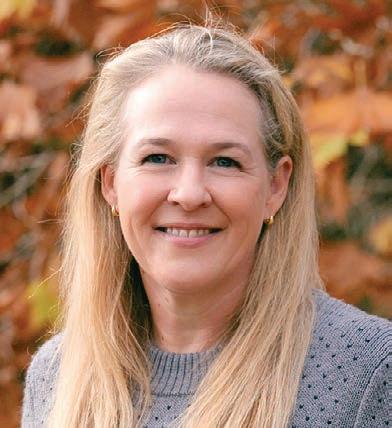
THERE’S a new type of leadership emerging in the wool industry, and it’s powered by collaboration.
Real collaboration is what I’m talking about. Not industry representatives debating what “should” be done “for” the sector.
I mean people with boots on the ground, working as a team, building a strategic platform and creating positive, sector-wide change.
This type of collaboration was seen in spades at the National
Fieldays recently. Campaign for Wool NZ was there, joining forces with Wool Impact and Wool Research Organisation of New Zealand (WRONZ) to ask one simple question: what do you want from your New Zealand wool industry organisation?
We handed people sticky notes to capture their views. And we listened to their concerns – really listened.
What we heard was both challenging and validating.
Growers are tired of the silos.
The work being done is good, but the sector is too small to stay disconnected. They want stronger, evidence-rich standards that authenticate and trace the wool they grow.
There’s a need for better training systems on farm and in shed. Information and choice about where and how they sell their wool to achieve better prices is lacking, as is clarity about where their wool goes and what’s needed in market. They want a united New Zealand wool story that drives quantifiable value – and ultimately, puts more P in their P&L.
Politicians – no matter which side of the house they debate from – were keen to support our collaborative efforts.
Manufacturers disclosed some of the challenges they face with on-shore processing and how
they are delivering workarounds while retaining fibre authenticity. The younger generation told us how they’re inspired to do things differently, but they want to feel more encouraged and empowered to share their ideas.
But at the centre of it all, the people we spoke to want united leadership and greater transparency. We often talk about the need for one voice representing the sector, but what was clear in our conversations was the need for a group that enables all voices to be heard, valued and aligned. We will never agree on everything, but we do need to be prepared to listen, identify common threads, and be agile enough to review and refine sector strategies as markets inevitably emerge and shift.
The heart of collaborative leadership is a growth mindset. This means that while we are always learning from each other, we also have permission to not know everything. It’s essential we surround ourselves with people who can plug our own knowledge gaps. This enables us to genuinely value different points of view, and yes, it means we sometimes need to pull back on a few of our own steadfast opinions. It’s not easy, but this shift in approach is where the gold is and it’s how we create a platform for positive
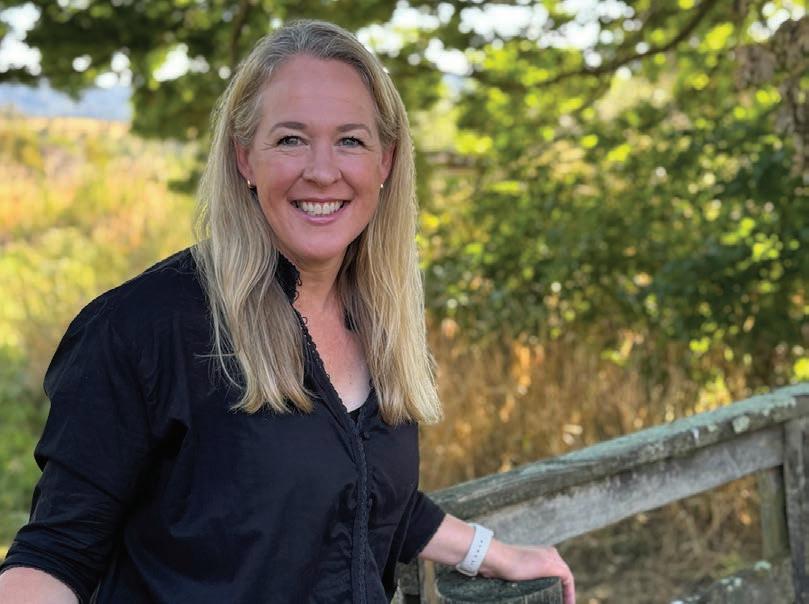
change to really take shape.
For the past couple of decades wool has been agriculture’s problem child, but I’m proud to say we’re growing up. Our wool sector is learning the lessons from the past and while it’s always important to check the rear-view mirror, our focal point is what’s ahead. I’m aware we are only in first gear, but the revs are up and we’re gaining speed.
Campaign for Wool NZ, Wool Impact and WRONZ have teamed up and are committed to delivering
a new way of working for the wool industry. We’re looking forward to sharing what emerges from our conversations with growers and the wider value chain in the coming months.
Those bright ideas, valued opinions and words of encouragement shared on sticky notes at Fieldays are all informing how we navigate a new path forward. The road won’t always be smooth, but I am optimistic this collective momentum is about to reshape the industry for the better.
I L D G O A T P R O B L E M O N Y O U R L A N D ?
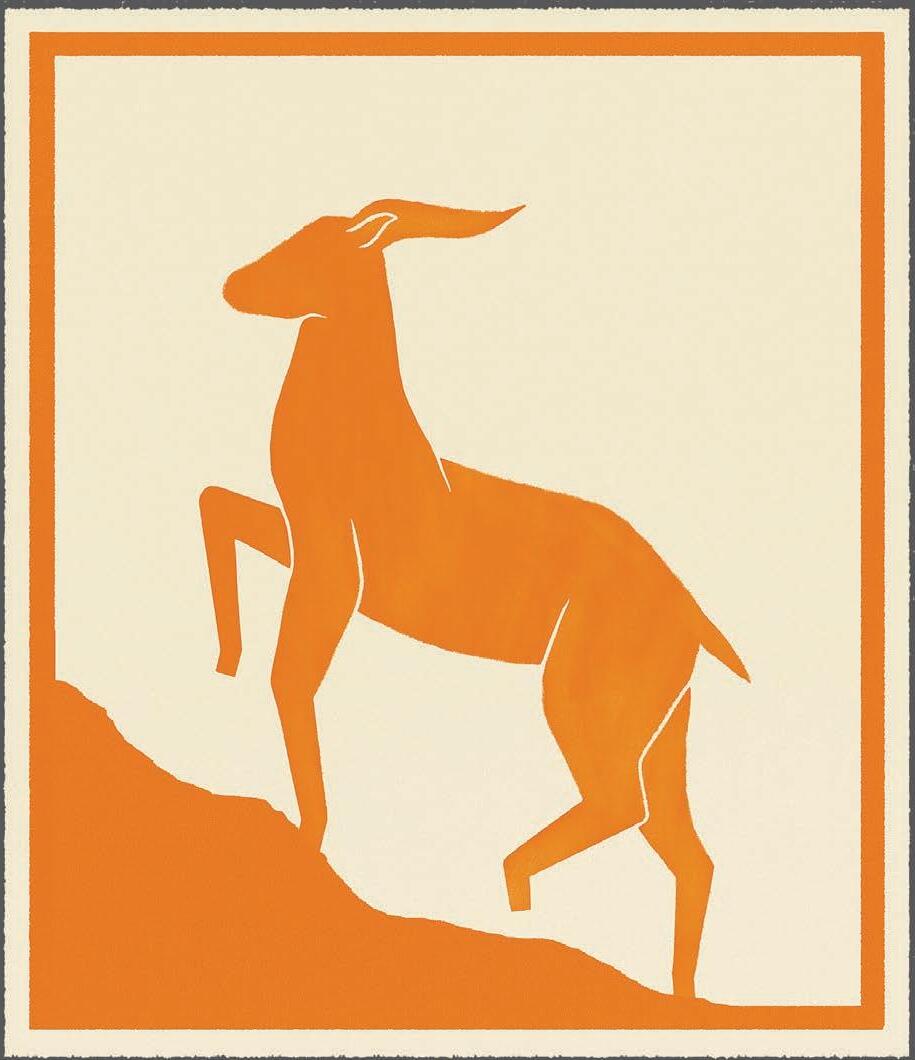
Kara Biggs Biggs is Campaign for Wool NZ general manager
GROWTH: Kara Biggs says the heart of collaborative leadership is a growth mindset. ‘This means that while we are always learning from each other, we also have permission to not know everything.’

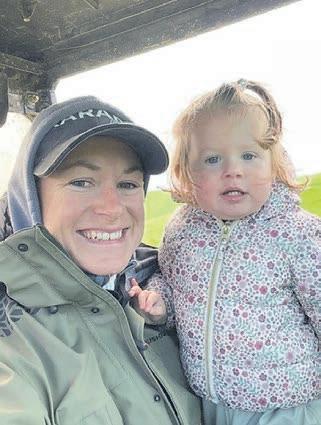
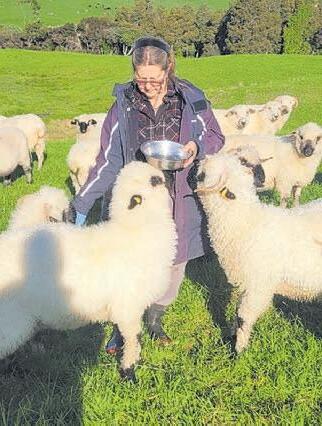
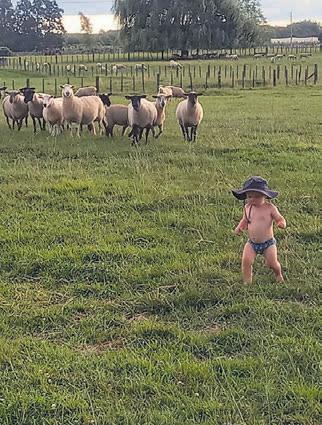
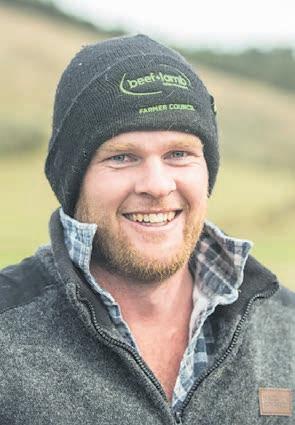
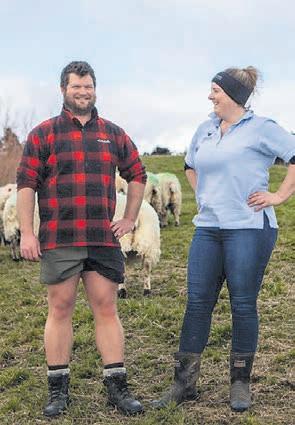

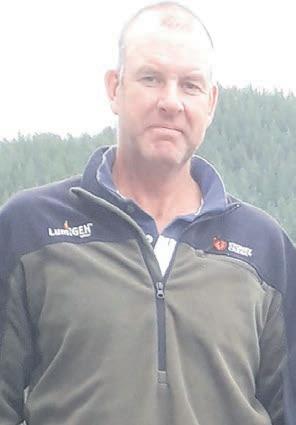




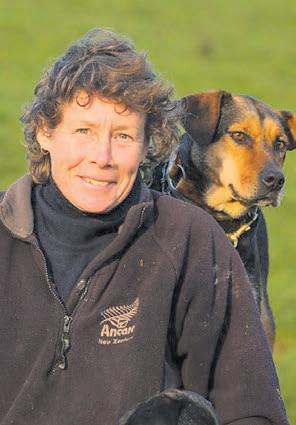

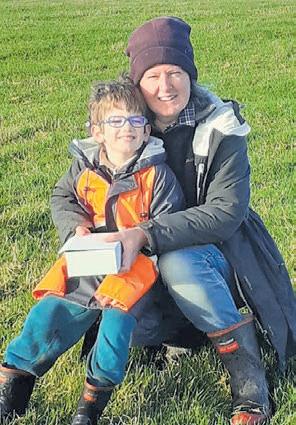
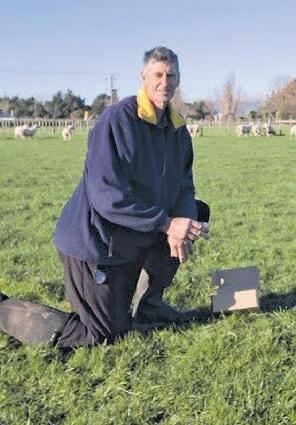


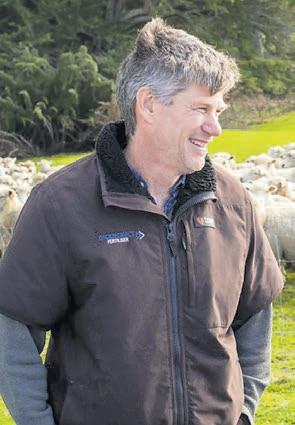
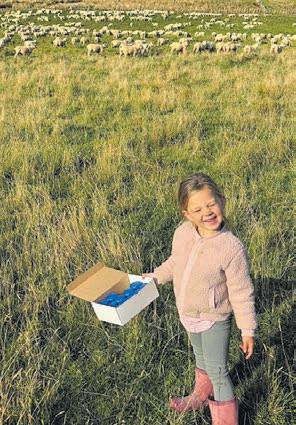

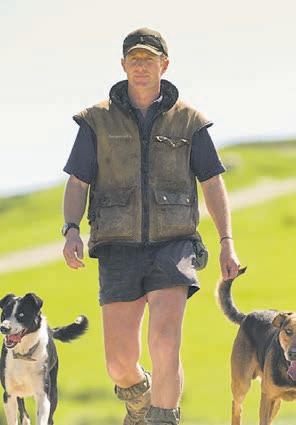


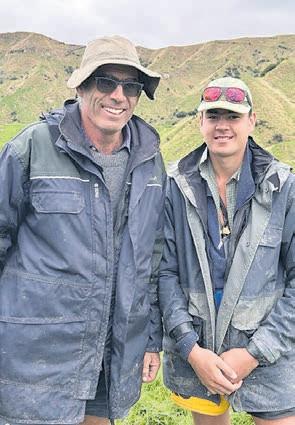

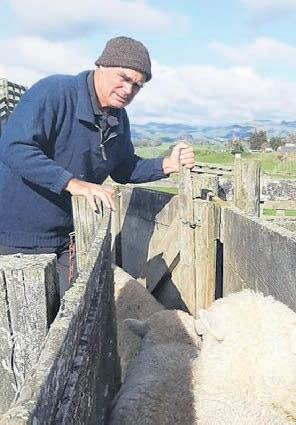
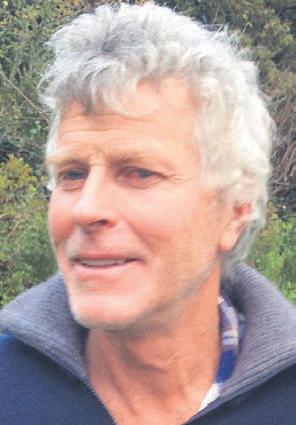
The Sheep Poo Study in action – mapping facial
eczema risk across NZ.

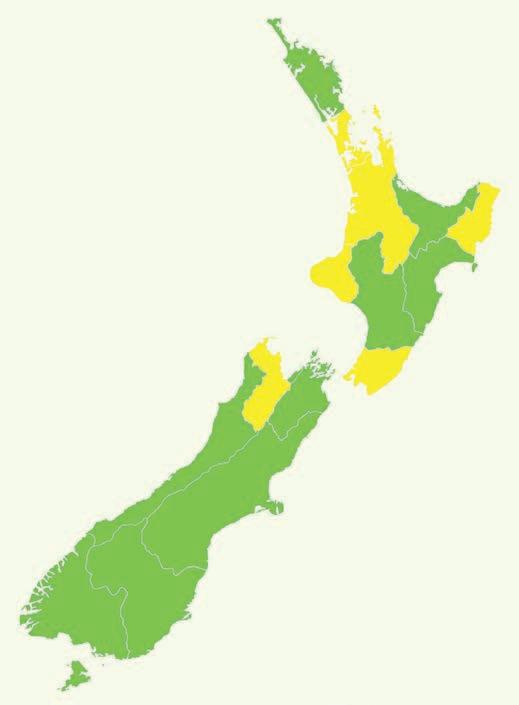
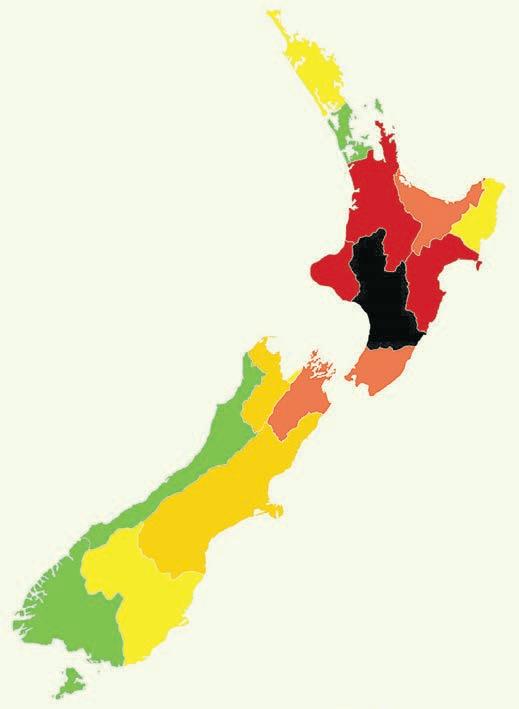
• The map is based on faecal FE spore counts from the 2024/2025 B+LNZ Sheep Poo Study
• Results are from 278 farms
• Presence of spores indicate potential FE risk
• For the West Coast region – no spores were found in the one farm tested, but the region has a history of FE Decembe 24
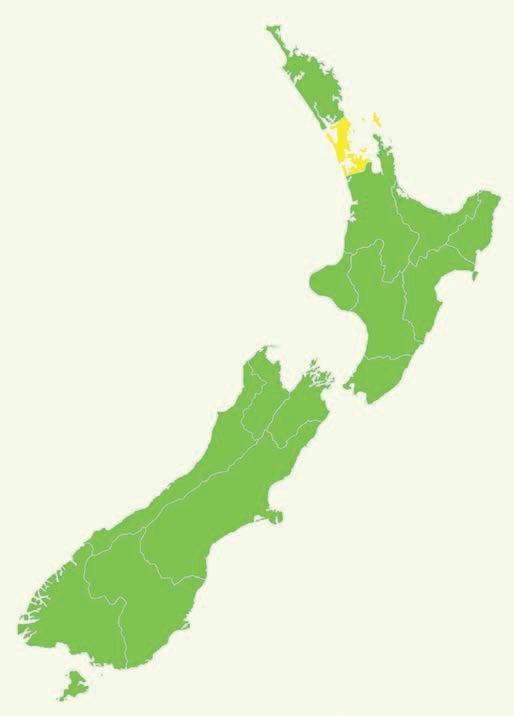
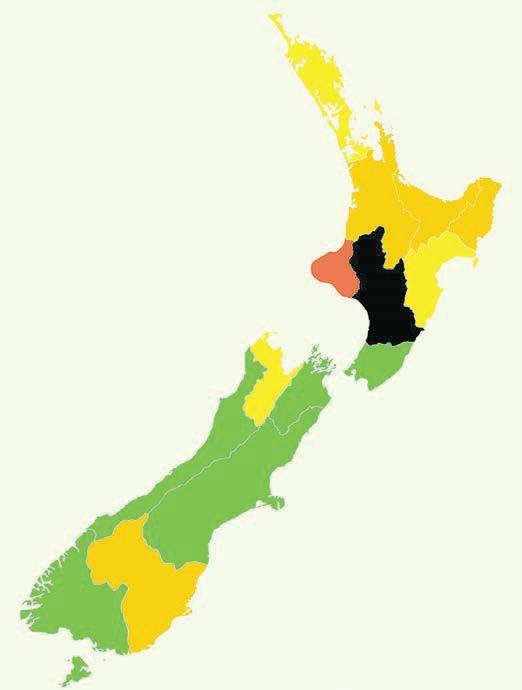
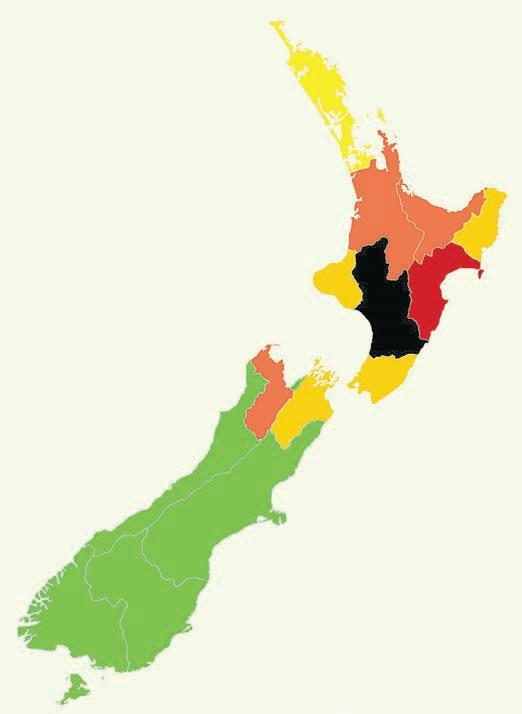
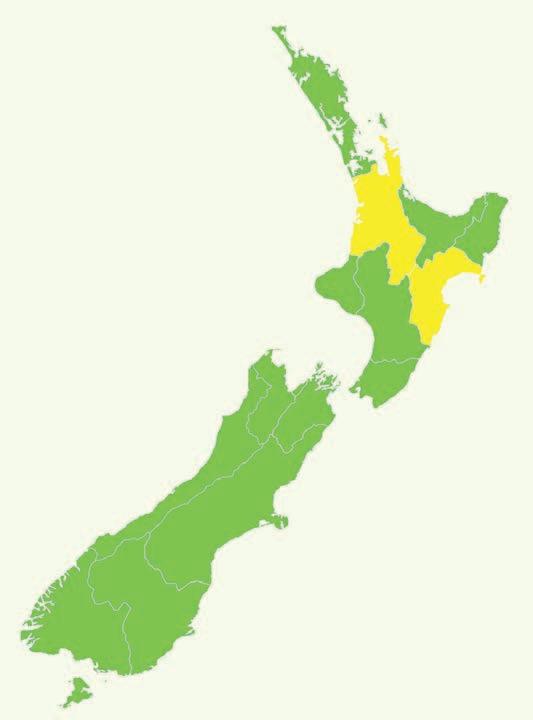

Deerstalkers are out to get your goat

Gerhard Uys NEWS Hunting
THE Department of Conservation and the New Zealand Deerstalkers Association want landowners and hunters to work together to reduce feral goat numbers.
The DoC wants landowners to open up their land for hunters
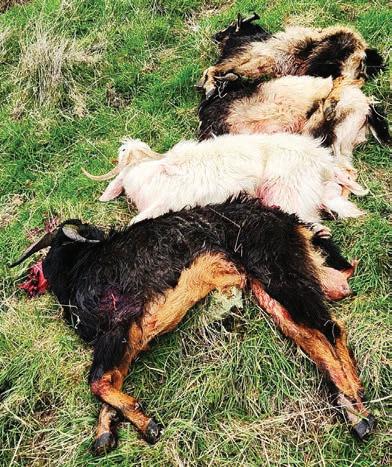
for the DoC National Wild Goat Hunting Competition that runs until November.
It said wild goats now occupy about 14% of New Zealand – about half of this public conservation land.
“Total population size is unknown but is estimated to be several hundred thousand.
“Wild goats are prolific breeders and pose a serious threat to native biodiversity and farmland.”
Doug Jacobs, a hunter from the New Zealand Deerstalkers Association (NZDA) Hutt Valley branch, managed to organise access to private land during last year’s goat hunting competition.
He said it is key that hunters and landowners form a relationship of trust.
During last year’s competition Jacobs used a community Facebook page to introduce himself and reached out to landowners to ask who had a goat problem on their property, and if he would be allowed to shoot goats for the competition.
A landowner responded to him, he said.
With some landowners never having allowed hunters on their property, it helped that he could assure landowners of his proficiency based on having
completed a NZDA hunts course. Through his NZDA membership he also has liability cover, he said.
He said he and the landowners worked through the NZDA’s “landowner assist” form.
The form lays out participant requirements, assures landowners that hunters won’t disclose the location of their property, and sets out how a hunter will enter the property, how they will retrieve animals, what locations on a property they are allowed to hunt and who to notify of their activities.
Jacobs said he had a meeting with landowners and they discussed specifics to the property, such as how to behave around horses on the property.
They did a walkaround of the property, and talked about notifying neighbours so they were not caught unawares by unexplained gunfire.
After a successful hunt, his relationship with the landowners grew and he is now a trusted hunter and is often asked to help cull both goats and deer on the property, he said.
DoC said hunters can use the hunting block search function to find hunting areas that have wild goats on public conservation land.

Over $70,000 in prizes are up for grabs, including gear from Hunting & Fishing NZ, thermal products from Nocpix powered by InfiRay, Bushnell binoculars and scopes,
From
nationwide.
Farmers urged to say how facial eczema affects them
Staff reporter NEWS Disease
BEEF + Lamb New Zealand has launched a national survey to better understand the impact facial eczema has on farmers. Called the Social Impacts Survey, it is part of broader Eliminating Facial Eczema Impacts (EFEI) programme that includes other sector organisations and the Ministry for Primary Industries. Its aim is to reduce and ultimately eliminate the

devastating impacts of facial eczema (FE) on New Zealand’s livestock industries.
The survey will help the programme to better understand FE and its effects on farmers and seeks input from sheep, beef, dairy, deer, and camelid (alpaca and llama) farmers.
Other projects contributing to the understanding of these impacts include the Sheep Poo Study, which is entering its third and final season. This study plays a key role in assessing the spread and severity of FE.


Earlier this year, an economic survey illuminated the financial impacts of FE, and this social survey is equally crucial.
FE affects more than profit and on-farm productivity; it impacts farmers’ sense of purpose and self-worth, and their relationships with their animals and families.
This human side has been underreported, BLNZ head of science and research Dr Suzi Keeling said.
“Facial eczema is a challenging disease to identify early and




manage. It affects the animals but also impacts their caretakers, leading to broader consequences for the entire farm business and other relationships.
“We know farmers are deeply connected to their animals; when animals suffer, it can take a real emotional toll.”
There is a separate survey for rural professionals like veterinarians and farm advisers.
Participants will help BLNZ get a better understanding of the effects on individual farms and support practical support tools, and on-
When animals suffer, it can take a real emotional toll [on farmers].
Dr Suzi Keeling Beef + Lamb NZ
farm strategies to reduce the burden of FE.
The 15-minute survey is open until Friday, July 18 2025.
For every completed response, B+LNZ will donate $10 to a charity supporting rural wellbeing.




Landowners can register their interest using the online form on the website.
gear from Hunters Element, and even a wild goat hunt with the team at NZ Hunter.
August 1, hunters can enter at Hunting & Fishing stores, participating NZDA branches and DoC offices
REDUCE: The Department of Conservation says wild goats occupy about 14% of New Zealand. If landowners open up their land to trusted hunters for the National Wild Goat Hunting Competition, they can reduce the number.
TRUST: Doug Jacobs, a hunter from the New Zealand Deerstalkers Association Hutt Valley branch, managed to organise access to private land during last year’s goat hunting competition. He says landowners and hunters should build a relationship of trust.
On-call tucker cutters now at your service

Rebecca Greaves ON FARM Agribusiness
PENDING weekends
Scutting up dog tuckers isn’t your standard couple’s bonding activity, but it works for Peter Gimson and fiancée Brydie Munn.
The young couple had been racking their brains for a side hustle that could help them get ahead, and they hit on a service that most farmers love to hate –processing dog tuckers.
Cull Converters offers a mobile on-farm dog tucker service. Using their custom-built trailer, the couple takes the hard work and heavy lifting out of doing dog tuckers.
“We kill, skin, gut and halve the animal, leaving you with meat ready to go in the freezer.”
Gimson and Munn live in the Whangaehu area, about 10 minutes north of Masterton on the farm where Gimson is a stock manager.
“It’s a breeding, trading and mixed cropping operation.”
Munn works full-time as an oral health therapist for children. She’s pretty sharp on a knife, and no wonder, her father is a homekill butcher. Munn grew up helping around the butchery, packing meat, although she never got on the knife, until now. She enjoys the butchery, though admits it’s not so good for the nails.
Gimson had no formal butchery skills beyond the basics he picked up as a shepherd doing on-farm dog tuckers, wild game or a mutton for the house.
“I learnt from my dad and other farms I have worked on. I picked up a few tips and tricks from Brydie’s dad.”
They pair had been trying to come up with a side business they
could do together in their free time or at weekends.
“We bought an investment property in Masterton and we wanted to pay down a bit of our mortgage. Hopefully it’s a stepping stone to buying our own land one day. We’re not sure what that will look like yet.”
They wanted to do something that would make farmers’ lives easier, but battled to think of a business that hadn’t already been done.
We kill, skin, gut and halve the animal, leaving you with meat ready to go in the freezer.
Cull Converters
One day they watched Munn’s dad winch skins off some sheep he was killing. They thought if they could replicate his fixed set-up, but make it portable, they could be onto a winner.
“We knew that killing dog tuckers was one of the least favourite jobs on farm. It’s pretty far down the priority list.”
They scribbled down a drawing of their idea, which a clever engineer friend was able to bring to life.
“We built a fold-out arm with pulleys. To be portable, it has to fold up. You need quite a bit of height to pull the skin off a ram in one pull. We had the trailer, so we knew our dimensions and it had to fit that. We drew a picture and he made it happen,” Gimson said.
The set-up enables them to process a ewe in about six minutes and a ram in about eight minutes. They’ve been operational for about five months and so far, they’re servicing the Wairarapa and Tararua regions. They’d consider
going further afield if the numbers stacked up.
“We’ve had a good response and some repeat customers already. They all say they love us,” Munn said.
Over his time working on stations, Gimson has observed how well his working dogs do on meat, especially when the work comes on.
“They don’t go so well on the cheap bikkies. Dog biscuits are getting so expensive and I don’t think some of them give the dogs much energy. I think the dogs prefer meat, too.”
It’s a win-win. Cull Converters can tidy up old cull rams or ewes, which have little to no value otherwise, and provide a good source of food for working dogs. He reckons they just need a few more people willing to give it a go.
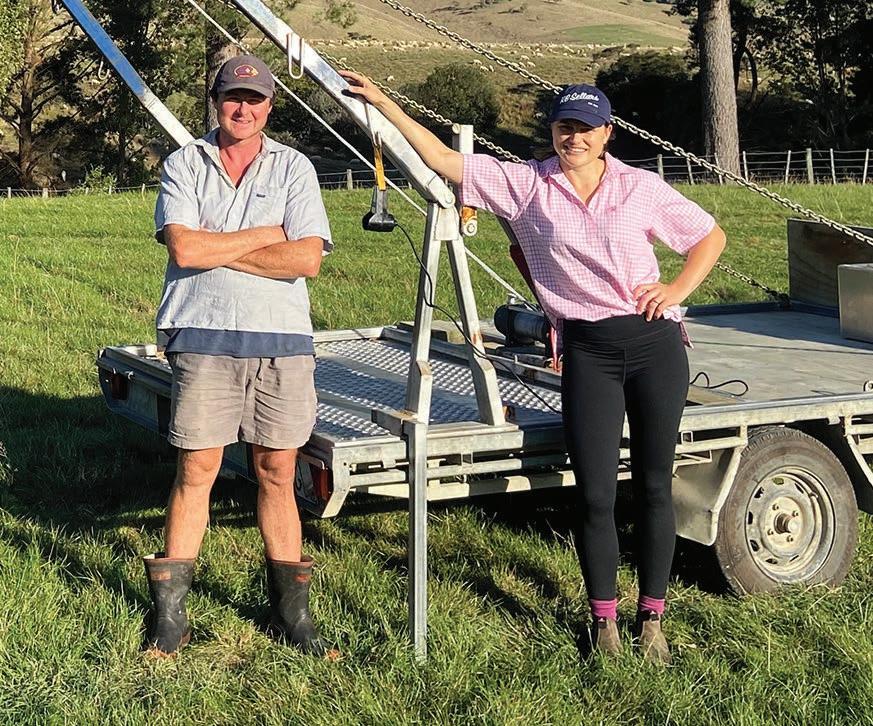
“People would have thought a crutching trailer was a crazy idea 10 years ago and now it’s normal. We’re hoping people will eventually feel the same way about
a dog tucker trailer.” Munn jokes that Gimson is just hoping for lots of business over winter so he doesn’t feel bad about retiring from rugby.
Applications open for Pāmu apprenticeship scheme
Staff reporter NEWS Training
PĀMU is now accepting applications for its 2026 apprenticeship scheme, offering a chance for aspiring farmers to launch their careers through full-time paid work, hands-on experience, and nationally recognised qualifications.
Based near Taupō in the central North Island, the scheme combines practical on-farm learning with formal study toward Level 3 and 4 New Zealand Apprenticeships in Agriculture. Apprentices live and work on operational farms, gaining realworld skills while earning a wage.
“We’re looking for motivated, open-minded individuals who are ready to get their boots dirty and be part of the next generation of food and fibre leaders,” said Aratiatia Farm manager Carl Carmichael.
“Whether you’ve grown up on the land or are simply curious about farming, this is a chance to earn while you learn and build a meaningful career.”
The 2025 intake of nine apprentices began on January 13 at Aratiatia Farm.
Their three-week induction included not only the robust Pāmu health and safety training, but also practical life skills such as cooking, budgeting, goal setting and flatmate agreements.
The programme has also
We’re looking for motivated, open-minded individuals who are ready to get their boots dirty.
generated strong interest from future applicants. Since January, over 170 expressions of interest have been received.
MORE: Applications close at 10pm on Friday, August 1 2025. The 2026 programme begins in January.














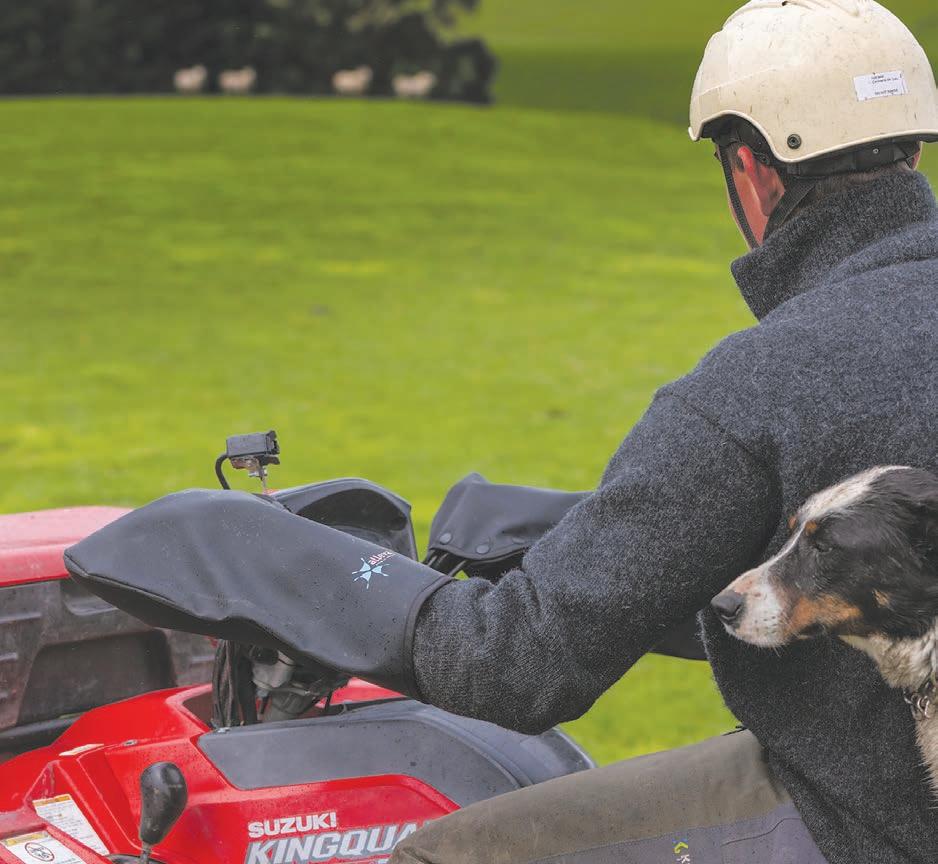




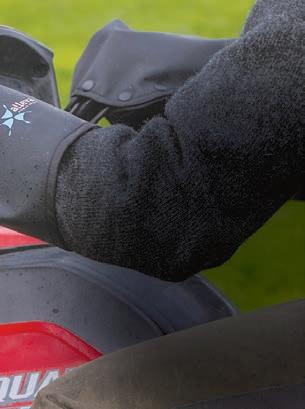







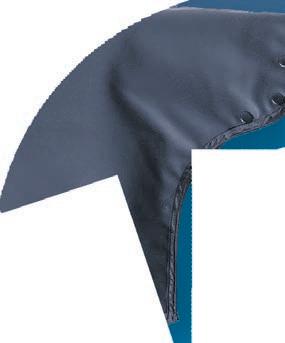















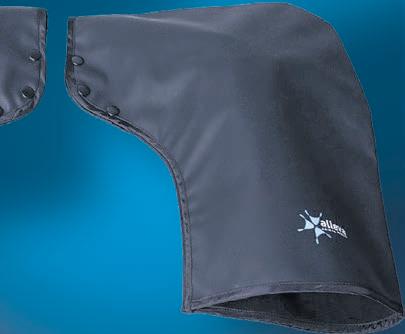







Carl Carmichael Aratiatia Farm
CONCEPT: Peter Gimson and Brydie Munn long mulled over a way to generate income, and when they finally settled on a dog tucker business, a friend helped them bring the concept to life.
Photo: Rebecca Greaves
NZ lessons apply in Mexican dry

Richard Rennie TECHNOLOGY Agriculture
THE decay of his family’s precious desert ranchland prompted a fourth-generation Mexican rancher to restore it with practices many New Zealand farmers would take for granted.
Alejandro Carrillo, a globally recognised regenerative grazing expert, visited Fieldays at Mystery Creek courtesy of Gallagher. He said electric fence technology played a big part in helping improve the health of the Chihuahuan desert his family farms.
The region is experiencing the sharp end of climate change. Once accustomed to 500mm of rainfall a year, it now sits closer to 250mm, with short intense rain events typifying the region’s precipitation.
But the decline in the 12,000 hectares the family ranches about three hours from the Texas border started almost a century ago.
“From the 1930s the land started to degrade, with loss of native grasses, biodiversity and topsoil. People said the type of cattle were to blame and the Herefords we had were swapped out for Charolais.” However, the breed did nothing
to lift land quality. Carrillo, meanwhile, was encouraged to go and get a university degree, ultimately graduating with a Master’s in computer science from Johns Hopkins University.
He spent several years working in financial sector software before returning in 2004 to help his father with the cattle operation.
“I came from a sector accustomed to almost constant change, to one that was quite conservative in adopting new practices.”
We have learnt that it was not so much the cattle, but how they were managed that did the damage.
Alejandro Carrillo Mexican regenerative farmer
In his absence the decline in the property’s stocking rate had become calamitous. The soil was retaining only 40% of the rainfall.
“So in a 10 inch rainfall area, only four inches was retained. We would be praying for rain every month, and when it did fall, we would be only six months before we were in a drought. I saw we
needed to reverse this if we were to remain viable,” Carrillo said.
Clearly traditional ranching was no longer working, and it prompted him to track down some of the world’s best regenerative farming practitioners for advice.
He also began travelling across all parts of the globe, including visiting grassland plains in several African countries, the United States and Australia.
Along with like-minded ranchers who became known as the “Magnificent Seven”, Carrillo increased the number of paddocks used across the estate using electric fencing, going from six permanent to 50-plus.
Stock became rotationally grazed, giving valuable native grasses time to fully recover before re-grazing. Twenty different grass species emerged, providing the better ground cover so invaluable for retaining rainfall.
“And we moved from 55 paddocks to as many as 1000 using electric fences, when conditions were right.”
He drew on work by respected Chilean pastoralist Arno Klocker, himself heavily influenced by New Zealand grazing management practices and who had adapted practices for use in lower rainfall, dry climate regions.
“In many respects it was the



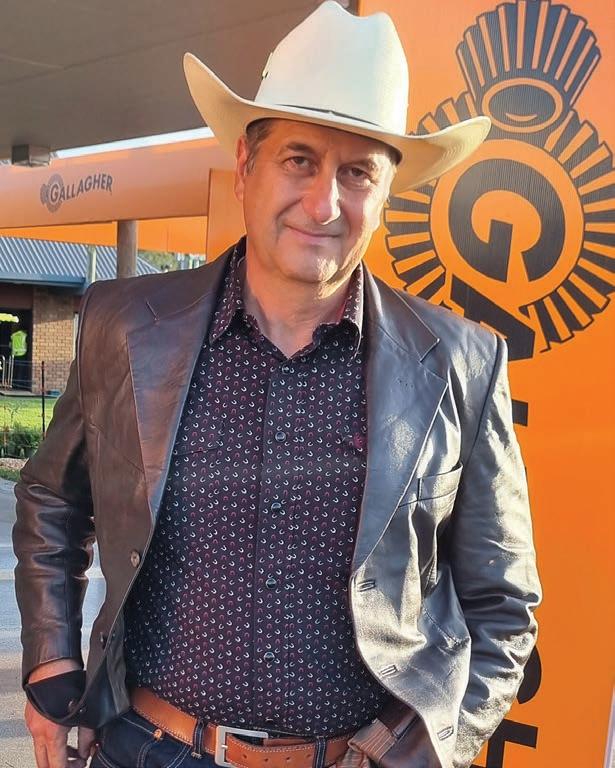
Kiwis who taught the Chileans how to graze.”
After 20 years of rotational practice, Carrillo said, the practice has spread across hundreds of thousands of hectares in a region that is similar in size to NZ.
Now he says 100% of the rainfall is held in situ by better ground cover and improved soil organic matter.
“Our grasses will stay green


RESTORED: Alejandro Carrillo says flexible electric fencing and careful rotational grazing have played a big part in helping him on a 30year journey to restore his family’s grazing lands to better health.
for up to eight months after the rainfall. It used to be we would go into drought only six months after rainfall before.
“We have learnt that it was not so much the cattle, but how they were managed that did the damage.
“I am trying to mimic nature and work with it to promote a better environment, one that can be farmed sustainably.”




FARMERS

Fresh faces at Federated Farmers
Karl Dean (36) and Richard Dawkins (35) have been elected to the Federated Farmers board at the organisation’s AGM in Christchurch, replacing Richard McIntyre and Toby Williams.
“It’s really exciting to have two capable young leaders like Karl and Richard stepping up into these significant national leadership roles,”
Federated Farmers president Wayne Langford says.
“While they may be new to our national team, they’re by no means new to Federated Farmers.
“They’ve held senior leadership roles within our organisation for some time now.
We’re lucky to have passionate young guys like Karl and Richard putting their hands up for some pretty big leadership roles within the sector.
Wayne Langford
Federated Farmers president
“Karl and Richard are both highly respected and experienced farmers within their regions and have worked their way up from the grassroots.
“I have no doubt they’ll both make a huge contribution.”
Karl Dean, who sharemilks with his wife Amie near Leeston in Canterbury, has been elected as the organ-
isation’s new national dairy chair.
He has previously held roles as Federated Farmers North Canterbury provincial president and vice-chair of the national dairy council.
“It’s a real privilege to be elected to the board, and I’m genuinely excited about the opportunity to help lead a constructive and future-focused dairy council,” Dean says.
“It’s also been a huge honour to work with Richard McIntyre over the past seven years on the dairy council, and his 12 years of service hasn’t gone unnoticed.
“His leadership helped shape a strong, positive culture, and I’m committed to carrying that legacy forward.”
Richard Dawkins, who farms with his wife Jess in the Waihopai Valley near Blenheim, has been elected as the organisation’s new national meat & wool chair.
He has previously spent five years on Federated Farmers’ national meat & wool council and two years as Marlborough province’s vice-president.
“It’s a huge honour to be elected to this role and I’m really looking forward to leading a young and dynamic team of meat and wool farmers who are passionate about the future,” Dawkins says.
“The face fronting the ‘Save Our Sheep’ campaign may have changed, but the team standing behind it remains the same. We’re ready to tackle the challenges sheep farmers face head on.”
Langford also acknowledges


the role outgoing board members Richard McIntyre and Toby Williams have played in a significant revival at Federated Farmers over the last few years.
“Both Richard and Toby have been real heavyweights who were absolutely relentless in their advocacy for farmers and rural communities,” Langford says.
“Richard is probably best known for his work calling for an independent inquiry into rural banking, but his legacy within Federated Farmers is so much bigger than that.
“He also put in a huge amount of effort pushing for better immigration settings for farmers, and changes to KiwiSaver rules that will really
help our next generation of young farmers.
“Toby’s impact has been enormous too. He’s the man who stepped up to put the final nails into the coffin of He Waka Eke Noa.
“He’s also led the charge in the fight against blanket carbon forestry on productive farmland, launching the iconic ‘Save Our Sheep’ campaign earlier this year.”
Langford says while goodbyes are always difficult, they also create an exciting opportunity for new leaders to step up, bring fresh thinking, and stamp their own mark on the future of farming.
“Nobody has a job for life at Federated Farmers. Our roles are up



for re-election every year and there’s always somebody waiting in the wings ready to step up.
“That’s what keeps us on our toes and accountable to our members at the grassroots - but it’s also what keeps the fire burning in our bellies to keep delivering tangible results for farmers.
“As an organisation, we’re lucky to have passionate young guys like Karl and Richard putting their hands up for some pretty big leadership roles within the sector.
“I know they’re going to make a real impact for farmers and will pick up the fight exactly where Richard and Toby left off. I’m looking forward to working with them.”
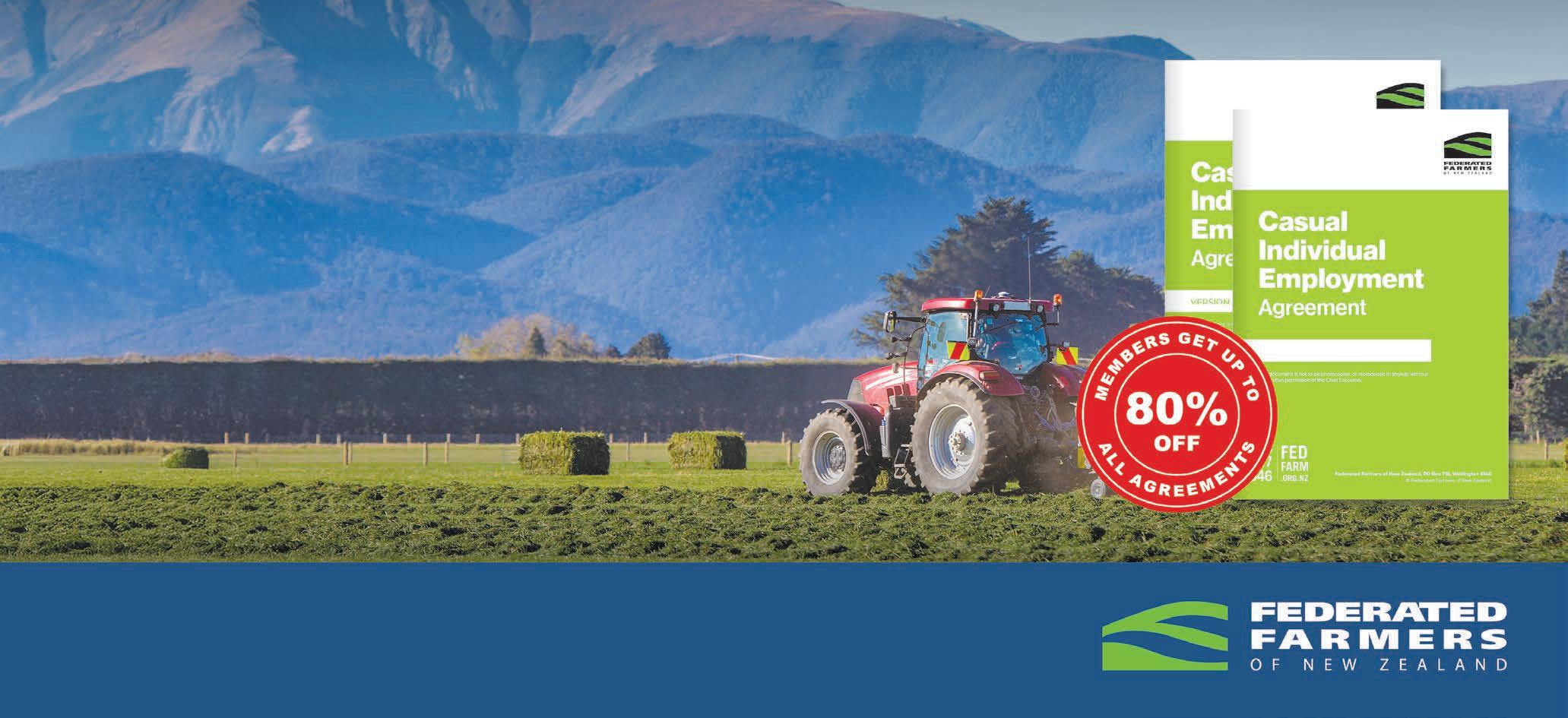
STEPPING UP: New board members Karl Dean and Richard Dawkins are looking forward to continuing the strong advocacy work of their predecessors Richard McIntyre and Toby Williams.
Agrichem ‘outcast’ risk demands action
Federated Farmers is warning that Government pressure on the Environmental Protection Authority (EPA) to speed up its processes has reached a crisis point.
“We’re now at very real risk of becoming a forgotten outcast at the bottom of the Pacific in terms of new agri-chemicals being available to us,”
Federated Farmers arable chair David Birkett says.
“We need the Government to step up pressure on the EPA and other agencies to cut assessment backlogs and prioritise new chemicals.
“Once those companies wind back their operations on our shores, it’s very unlikely they’ll come back,” Birkett says.
Bayer Crop Science recently announced its decision to close its Hastings research site and stop work on any new crop product trials in New Zealand.
In a letter to Cabinet ministers, Bayer NZ said it will no longer have field agronomy staff based in New Zealand from October.
“While this is not a decision we have taken lightly, the current operating environment in New Zealand means we do not see opportunities to start new projects that would introduce our pipeline crop protection products in this market.”
Birkett says Bayer is by no means the only company to highlight New Zealand’s cumbersome safety assessment and approval systems for agri-chemicals and animal health treatments.
“It’s not over-starting the threat to say that Bayer may be just the first cab off the rank in terms of agrichemical specialists de-prioritising the New Zealand market for release of new products.
“The chorus of complaints about the EPA’s assessment backlog and priorities has grown to be almost deafening – including from Federated Farmers,” Birkett says.
Another global crop protection and seed treatment giant, Syngenta,

We’re now at very real risk of becoming a forgotten outcast at the bottom of the Pacific in terms of new agrichemicals being available to us.
David Birkett, Federated Farmers Arable Chair
has also signalled New Zealand is no longer a priority country for introduction of its new products.
As Farmers Weekly reported earlier this month, Official Information Act searches reveal Syngenta has deliberately avoided NZ registrations for several crop chemistries, including actives to control grass grub, fall armyworm, crown rot, fusarium and nematodes.
Birkett says his conversations with representatives of other agrichemical companies shows they are also re-assessing their New Zealand footprint.
“It’s very clear we need to move on this very fast.”
The Government launched the Agricultural and Horticultural Products Regulatory (AHPR) Review last year.
This was spurred by a 2023 report that showed delays in getting new product approval had blown out to three times longer than a decade earlier.
Birkett says Federated Farmers and the wider industry welcomed announcements last month that upcoming changes will make it easier for applicants to apply in cases where chemicals have already been used safely in other countries.
Other changes to be introduced

in an omnibus AHPR bill would allow temporary use of some products under certain criteria, and would improve transparency around application timeframes and processes.
“The recommendations are good,” Birkett says.
“But the Government needs to demonstrate how quickly those changes will happen.
“As the Bayer announcement and other industry signals show, the ship is sailing.
“These companies need solid reassurance we’re addressing the red tape urgently.
“The hard truth is, even if these recommendations were actioned immediately, the backlog is such that it would take years for the EPA and other approving authorities to work through the list.
“We don’t have years to make this right. Farmers and growers are extremely concerned about the future of agri-chemicals in NZ and how we will replace older chemicals that are being removed.
“We are currently unable to compete with many of our international competitors due to these delays”
Birkett says, in particular, he wants to see the EPA prioritise new chemicals.
“Just the other day they announced they’d processed nine applications but they were all for generic chemicals that are already available, so no-one’s really gained anything.
“It’s the new chemistry we need to get through. It gives farmers latest and best tools and gets round the problem of resistance built up to old chemicals. We can then remove the less safer agri-chemicals from the environment.”
He agrees the relatively small size of the New Zealand market plays into continued agrichemical company interest here.
“I was told by one senior representative those economic factors – our relative isolation and so on – were perhaps 30% of the issue. But the other 70% is getting our regulatory systems right.
“I’m pleased to see Ministers Simmonds and Hoggard put hard deadlines on the authorities to start to reduce the hazardous substances, new organisms, agricultural compounds and veterinary medicines assessment backlogs.
“The big question growers are asking is, are these actions too little, too late to stop any more agrichemical companies from following Bayer’s decision.”


NEW TOOLS: David Birkett says the priority for assessment is new chemicals that will give farmers the latest and best crop and pest treatments.
CONCERNS: Farmers and growers are extremely concerned about the future of agri-chemicals in NZ, says David Birkett.
Farmers fed up with feral pigs and deer
Otago farmer Gavin Marshall has had a gutsfull of feral pigs eating his lambs, and he’s expecting things to get even worse with more trees going in next door.
Marshall, who runs a 1000ha sheep and beef farm in Crookston at the top end of the Blue Mountains, says the past three years have been a nightmare at lambing time.
“We have a big tussock block where we put singles in October, and we’ve had 35% come home without lambs for the last three years,” he says.
“You expect to lose 10% to natural causes, but an extra 25% is a lot. That’s about 100 lambs we’re losing to pigs every year.
“They leave only the skull and skin – that’s all that’s left.”
Marshall says the issue stems from pigs breeding in a neighbouring forestry block.
“When I bought the place 28 years ago, you hardly saw a pig. But the trees went in 25 years ago, and now it’s terrible – they’ve got cover, and they’re breeding like mad.”
The neighbouring forestry company has shown some sympathy
but that’s not enough, Marshall says.
“They gave us a pig trap – we haven’t caught a single one.
“What we need is proper control –contract hunters, recreational access, bounties – anything to knock these numbers back.”
He fears things will only get worse, with a neighbouring 1000ha farm recently sold into forestry.
“The farmers who sold were sick of the pest problems and moved to another district.
“More forestry going in will just double the problem – or more.”
Pigs aren’t just killing lambs –they’re wreaking havoc on pasture too.
“They come in at night and root up paddocks. You wonder why you bother spending money on pasture renewal.
“They’re worse in the second year of grass – they just rip it up.”
Marshall has tried putting out dead cows to distract the pigs, hoping full bellies might mean fewer lamb losses.
“They didn’t touch them. It’s the newborns they’re after.”
Meanwhile, down the road in Tapanui, it’s feral deer causing

headaches for dairy farmer Trev Isteed.
He says the neighbouring DOC block is a breeding ground for deer that hammer his pasture.
“We’re probably feeding 15 to 20 deer a day, which is around $50k a year’s worth if you replaced that with cows eating the grass.
We bought a thermal scope a few years ago and it’s probably the worst thing we’ve done because now we can see how bad the problem is.
Trev Isteed Tapanui farmer
“We’re at the stage now where we’re looking at deer-fencing it to keep them out. I’ve done a rough calculation and that’ll cost about $35-$40k.”
Isteed and son Glen have asked DOC if they’ll help with that bill – but with no luck.
“They gave us a flat ‘no’. They simply will not pay for anything other than sheep fencing.”
Likewise, DOC won’t spend any money on pest control, Isteed senior says.
“They’re terrible neighbours.”
A retired chap from Dunedin comes up possum trapping on the farm every week and he’s caught around 900 possums over the past three years.
“And that’s with only 20 traps,” Isteed says.
“That 220 acres of DOC land is actually classed as a non-hunting block because there’s houses nearby, which is fine, but they need to be doing something to control the pests.
“We bought a thermal scope a few years ago and it’s probably the worst


NIGHTMARE: Gavin Marshall is losing about 100 lambs to pigs every year – and he’s sick of it.
thing we’ve done because now we can see how bad the problem is.
“When you can shoot these deer out the back of the house, you know you’ve got a problem.”
Son Glen says he shot 11 deer in one sitting recently and they’ve shot around 400 deer in the past decade.
Federated Farmers Otago president Luke Kane says the Government needs to mandate enforceable pest management plans for forestry operations.
“These forestry conversions are creating pest havens. We need the Government to step in and hold forestry operators responsible,” he says.
Kane also wants Otago Regional Council to include pigs and deer in its regional pest management plan.
“They don’t need to do it across the whole region. They can take a site-specific approach, like Canterbury has with feral goats on Banks Peninsula – it’s been really effective.”
Kane says a Central Otago farmer recently told him he’s losing more than 20% of lambs to pigs living in matagouri scrub, but he needs resource consent to clear it.
“That’s madness. A common-sense approach would be to allow farmers to clear scrub for pest control.”
With forestry plantings increasing and no meaningful control in place, Kane says the problem is only going to grow.
“Unless forestry companies step up, we’re going to lose more lambs and pasture – and livelihoods.”

Families across New Zealand are facing the cold with no safe place to call home. Kids are sleeping under thin blankets. Parents are choosing bet ween food, heating, or rent




Farmers like you have stood with The Salvation Army since 1885. Your support means help stays local warm beds, full pantries, hope
ISSUE: Gavin Marshall says the issue stems from pigs breeding in a neighbouring forestry block.
Farmer finds place in the Feds’ fold
If you want change, you need to be a part of it, says a 22-yearold who has joined the Waikato Federated Farmers executive.
Jayden Corbett was motivated to come to Waikato Feds’ meetings after hearing and reading about wholefarm conversions to carbon forestry.
“It didn’t sit right with me,” he says.
“I’m a young guy starting out a career in sheep and beef and heading for the hills but they’re planting out so many of the hills in pine trees.
“I reasoned there was no point just sitting at the dinner table every night and complaining about it.”
Corbett headed to the Waikato Federated Farmers 2024 AGM and found fellow farmers who encouraged him to join in, listen, learn and have a say.
“Federated Farmers took me under their wings, and then president Keith Holmes was keen to see me grow my Feds’ involvement.”
Waikato Feds sponsored him on a one-day leadership workshop that covered topics such as the difference between governance and operational matters, conflict resolution, how to run an effective meeting, and setting values and a strong culture.
“It was excellent. I’d got myself into a couple of positions helping at the golf course and the local hall, so it
was also it was quite useful to take those skills back to those smaller community groups.”
Corbett was invited down to Wellington to attend a Feds Meat and Wool Council meeting and, with the value of succession planning in mind, Waikato meat and wool chair Reon Verry suggested he might consider becoming his vice chair.
And that’s exactly what came about at the province’s AGM in May.
I’m a young guy starting out a career in sheep and beef and heading for the hills but they’re planting out so many of the hills in pine trees.
Jayden Corbett Federated Farmers Waikato meat and wool vice chair
It’s not the first time Corbett has shown willingness to seize opportunities.
He grew up on a small dairy farm at Waerenga, about 20 minutes out of Te Kauwhata in North Waikato.
His granddad was the father figure in the household and while Corbett helped in the cowshed and fed out hay from a young age, his gaze was to the hill country of neighbours’ farms.

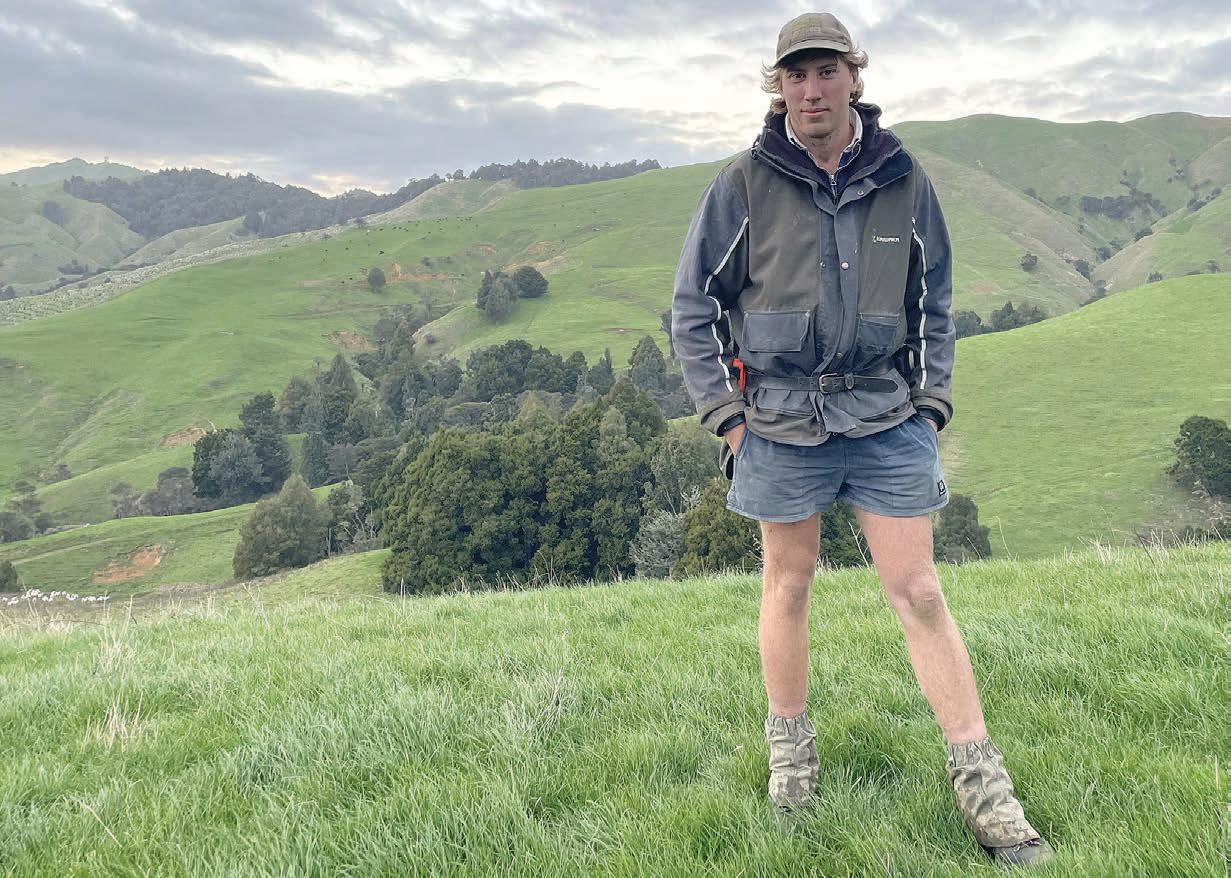
“I cottoned on pretty quickly I didn’t want to be a dairy farmer; the early starts weren’t my cup of tea.
“I wanted to be a sheep and beef guy and get off the flats and into the hills.”
At age 14, he knocked at the door of one of those neighbour’s farms and asked about work.
From then his high school holidays and some weekends were taken up with helping in the shearing shed and other farm tasks.
A little bit older and with more experience, he approached another neighbouring farm in the Matahuru Valley.
“That whole summer I was rolling up fences down in the gullies.”
Seven years later, he’s still on the same property and he’s worked his way up the ranks to be manager.
It’s a 1000-hectare drystock operation raising beef cattle across
multiple properties on LUC 6 and 7 land, some of it pretty steep. Corbett has two shepherds and a general hand under him.
“My bosses are young. I’m young. We get along and when I’d shown I was up to the tasks, they didn’t let my age get in the way.”
The ultimate aim is owning his own place, so he’s very supportive of the work Federated Farmers has put in to try to secure more competition in the banking sector, and to persuade the Government to allow young farmers access to their KiwiSaver funds to buy a first farm or herd.
As a step up the ownership ladder, he’s leased the family dairy farm and is taking it to beef for the first time.
“It’s about 100 hectares and me and granddad are working closely together to put it into intensive beef on the flat country.”
Corbett says better KiwiSaver access and a fairer deal from banks could make a big difference to young farmers – and the succession plans of the older generation.
“I had my own struggles with banks just trying to secure the lease and stock. They almost turned a blind eye when I told them I was 21 going on 22.”
His own experience is that Federated Farmers welcomes younger members and will find a fulfilling role for them.
“We need a stronger farming voice now more than ever, especially with our district and regional councils.
“Building up some better communications with younger farmers is important and I also think we can reach out more to other groups to see where our interests align.
“I’m keen to be a part of that.”
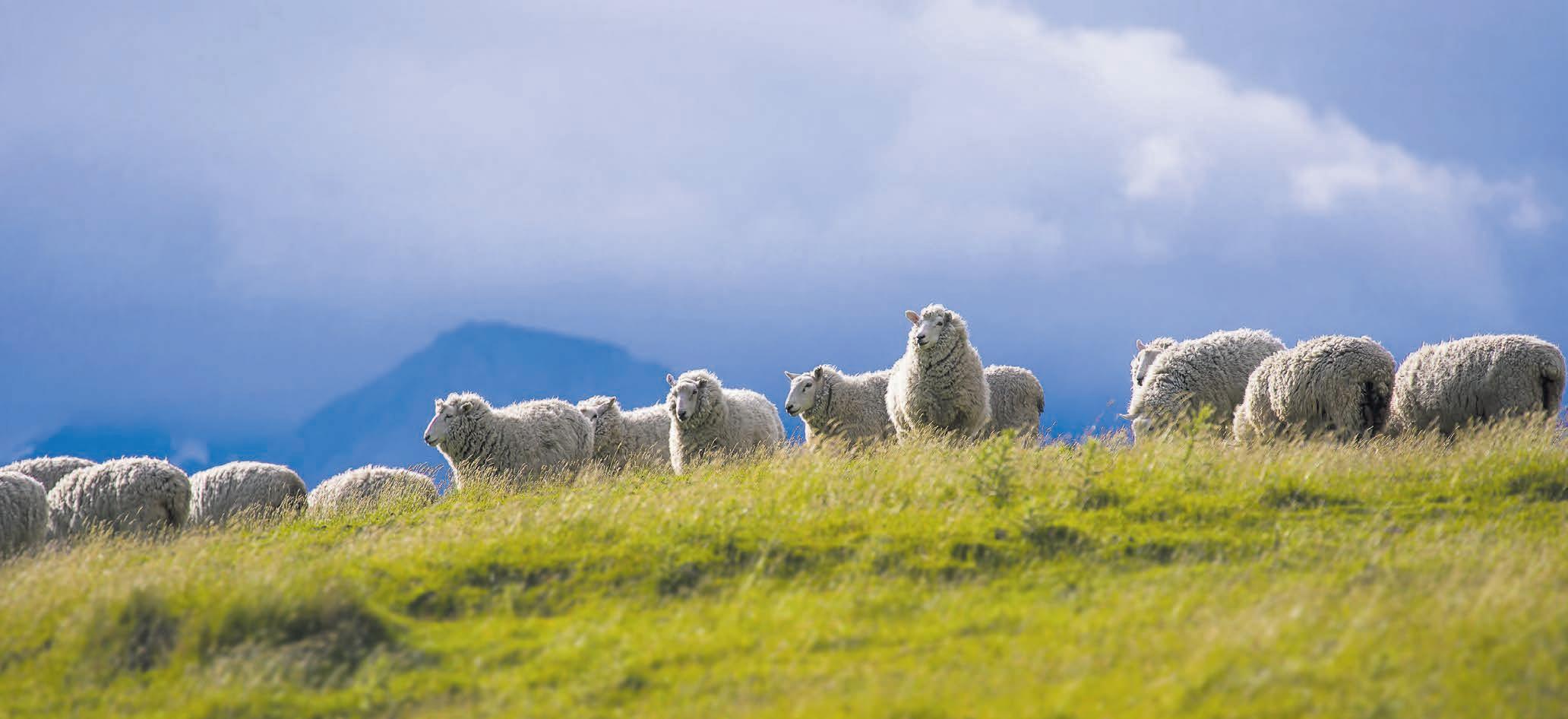
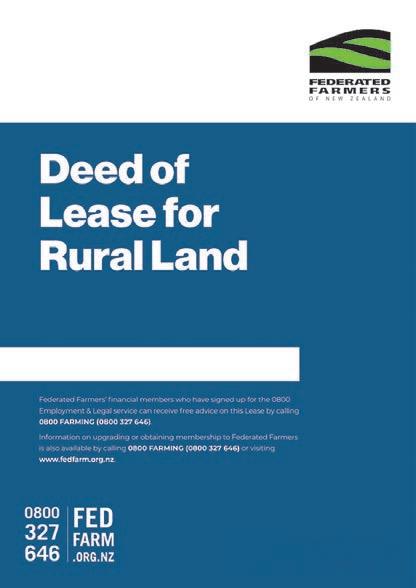

STEPPING UP: Jayden Corbett is a farm manager at age 22. ‘My bosses are young. I’m young. We get along and when I’d shown I was up to the tasks, they didn’t let my age get in the way,’ he says.
DEAL: Jayden Corbett says better KiwiSaver access and a fairer deal from banks could make a big difference to young farmers – and the succession plans of the older generation.
Mayfield 1444 Maronan Valetta Road
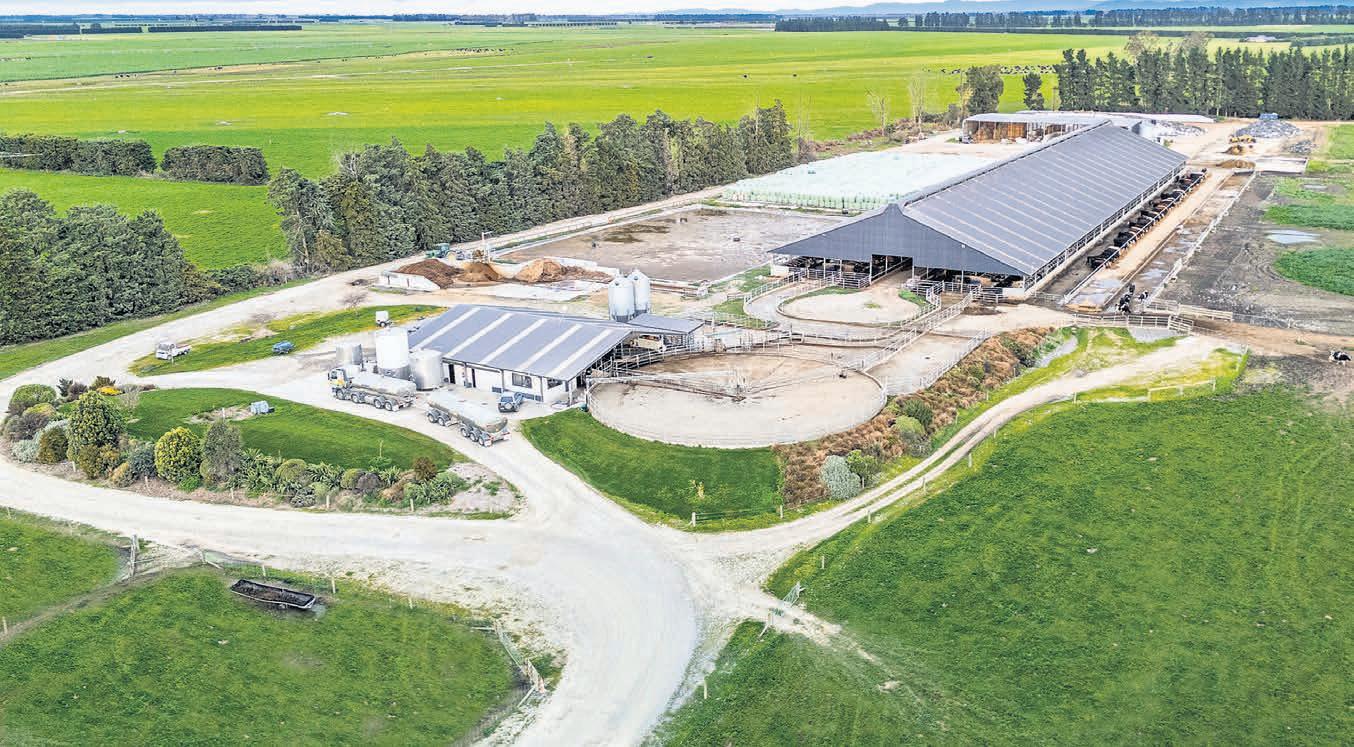
This well presented smaller dairy farm has huge potential for that special operator. Located in the
farm is surrounded by dairy and dairy support farms. It is approximately 25 minutes west of Ashburton and 15 minutes south of Methven. Special features include: 5,000 m2 barn with 630 loafing bays, 50-bail rotary dairy shed with full automation, huge range of additional sheds, lateral move irrigator, Mayfield Hinds Valetta irrigation water,
soils and two good homes and single accommodation. Milking 620 cows in the barn over winter and a further
approximately during the summer. Also running approximately 200-600 beef animals that are
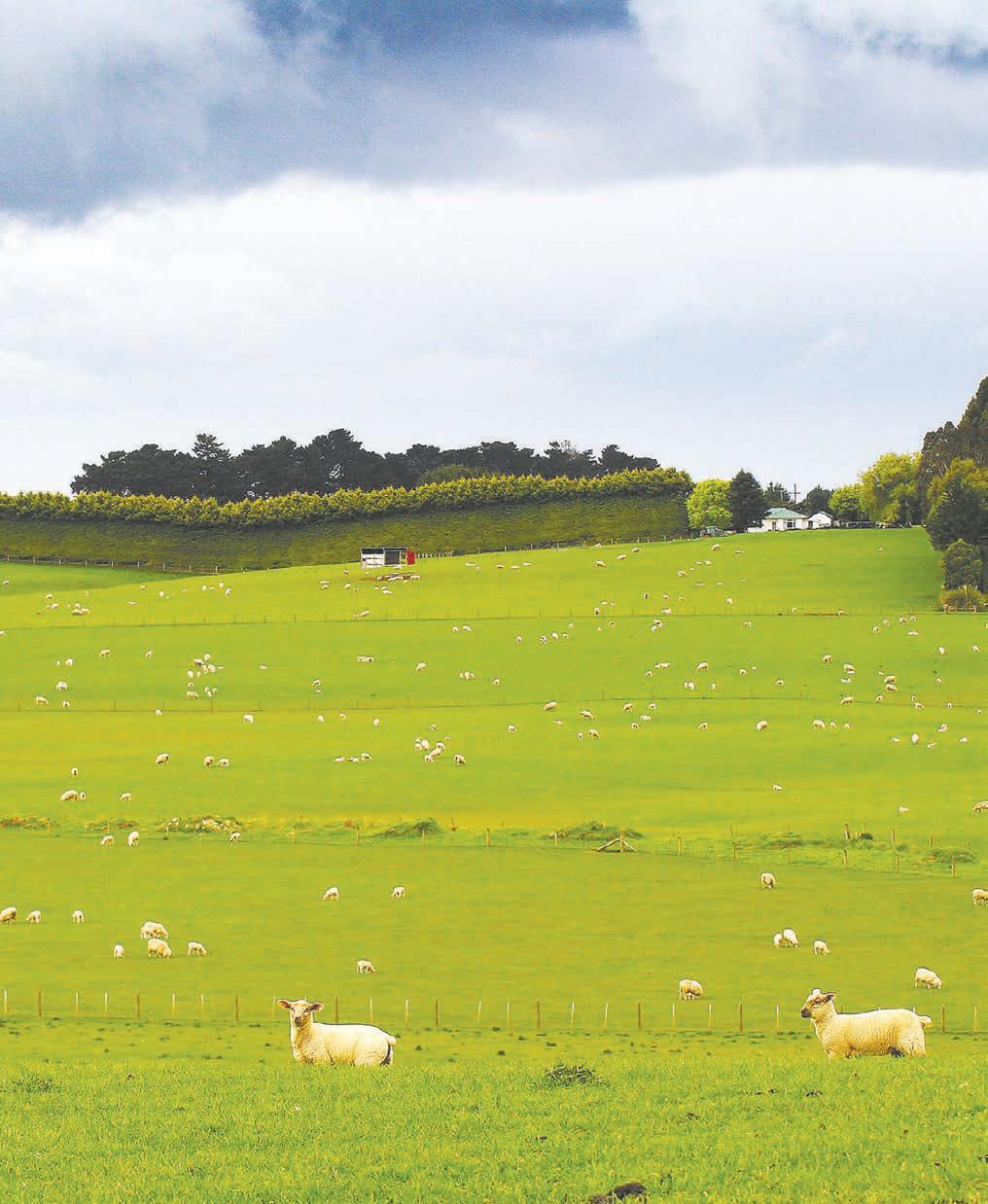
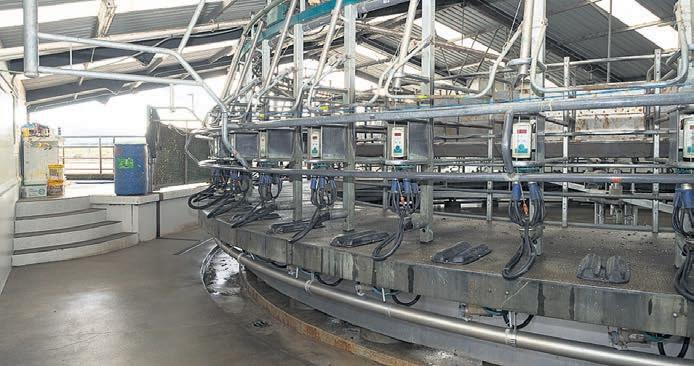
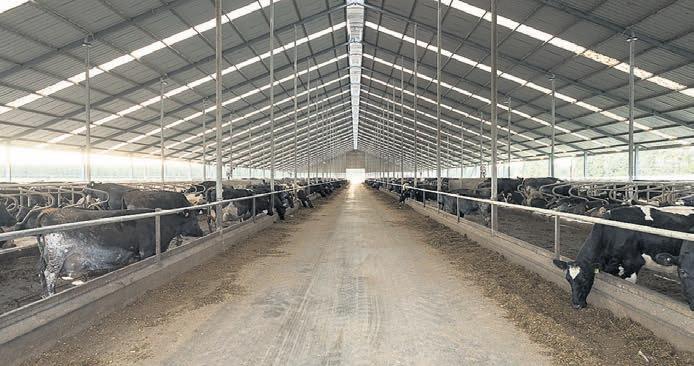

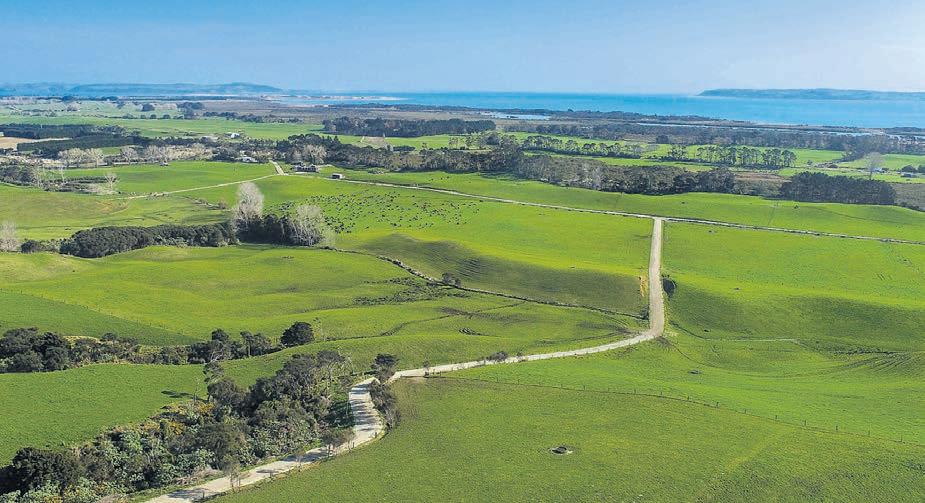
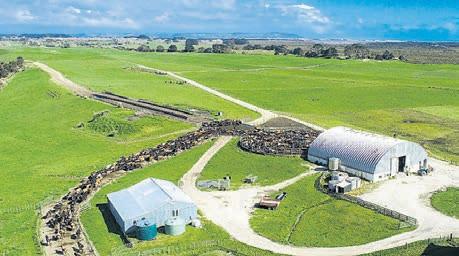
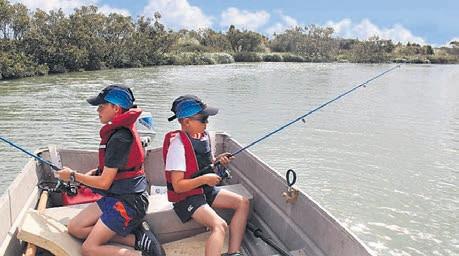
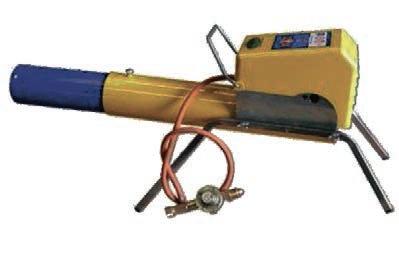


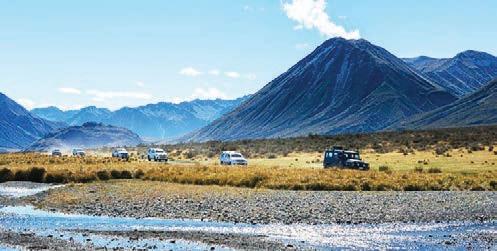
•
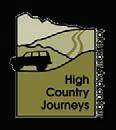


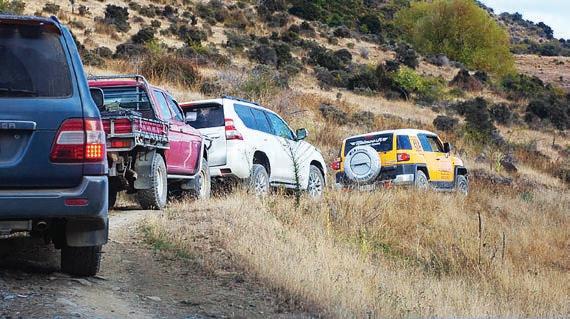
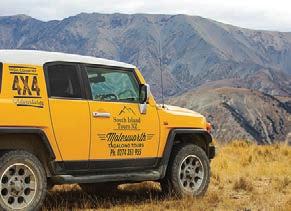














UPCOMING MATAWHERO C AT TLE SALE
Tuesday 15 July | 11am Grand opportunity to purchase hill country station bred cattle.
Contact:
Jamie Hayward 027 434 7586
Follow us online for updates: Agonline.co.nz
Livestock - East Coast

LINKING BUYERS AND SELLERS
SERVICES INCLUDING:
• Buying and selling
• Forward Sale & Purchase
• Livestock Valuations
• On-Farm & Online Auctions
• Service Bulls With options for:
• Purchasing
• Finance-A-Bull
• Lease with Link-A-Bull
CONTACT OUR TEAM OF EXPERIENCED AGENTS COVERING ALL OF NEW ZEALAND www.linklivestock.co.nz or email accounts@linklivestock.co.nz
SALE TALK
A man foolishly asked his wife why she kept staring out of the window.
Taking a very deep breath she replied, “I’m really fed up with the state of Mrs Brown’s blinds. Mrs Perkins’ aren’t much better. And that Mrs Lewis - scruffy cow. Look at them - filthy. They’re just not house proud like me. Dirty blinds are such an eyesore. If you were a real man you’d go over and get them to do something about it. In fact, you must - I won’t stand for it any longer.”
“I’ll tell you what,” her husband said as he peered through the window beside her, “I’ll see what I can do.” The following morning, she approached him, beaming.
“I can’t believe it. The blinds. They’re all immaculate. What did you say to those women?”
“Nothing,” he told her, “I just cleaned the window.”
If you’ve got a joke you want to share with the farming community (it must be something you’d share with your grandmother...) then email us at: saletalk@agrihq.co.nz with Sale Talk in the subject line and we’ll print it and credit it to you. Conditions apply
PRELIMINARY NOTICE
Annual Surplus Plant, Machinery & Feed Auction
Calling for quality entries, particularly machinery, animal handling equipment, baleage & hay
Entries close Monday 21st July - 5:00pm BIDR will be operating for the sale of


hazlett.nz Corner Beck Road & Pleasant Point-Cave Highway Friday 25th July 2025 - Commencing 10:00am Further Enquiries : Wayne Andrews - 027 484 8232 Hamish Zuppicich - 027 403 3025 Timaru Office - 03 687 4440 Entry form online at : https://www.hazlett.nz/whats-on/


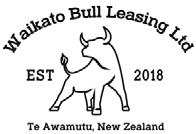

Male & EweLambs33–38kg LatebornSayOctLambs28–32kg
GAPMASILEwesTermRamApr
R1YRFriesbulls180–220kg
R2YRHeifers330–400kg
R2YRAngus & AngXSteers330–400kg
R2YRBeef & FriesBulls420–560kg
info@dyerlivestock.co.nzwww.dyerlivestock.co.nz RossDyer0274333381





027 656 8782 www.fernleaframs.co.nz For healthier stock, resistant to worms and facial eczema



Helping grow the country
PGG Wrightson
Is this the ceiling for export lamb value?
There has been little indication that global supply will recover next season, which should continue to support pricing as long as demand does not falter.

Alex Coddington MARKETS Beef and lamb
RECORD-breaking average export values for lamb were posted in May. At $13.83/kg, lamb is trading 23c/kg above the previous record set in March 2022, and $2.76/kg above the five-year average. With the value of export lamb at levels never seen before, questions are being raised as to whether this is the ceiling for export lamb value.
Since May, export returns on our main lamb cuts have been steady to slightly firmer. However, with signs of resistance creeping in from some of our higher-paying markets, it will be important to watch how these markets track against the expectation that farmgate prices will continue to lift.
Although exporters have never received more for lamb, farmgate prices at $9.55/kg are still 10c/ kg shy of breaking any records. Considering we are still only in July, it is expected that farmgate pricing records will be broken if they continue to follow normal seasonal conditions.
While higher prices at the farmgate are great for both the industry and farmers, it is arguably
more important that these levels can be sustained.
In 2021, late September prices peaked at $9.50-$9.60/kg, and were sustained through 2022 before falling quickly back to $7.66/kg by Christmas. Back then, Chinese demand was the cornerstone of that price strength before demand unexpectedly fell away when their pork inventories fully recovered post-swine flu. This caused lamb prices to quickly return to previous lows due to a lack of alternative market support.
In May this year, despite rising input costs and a volatile dollar, processors were still paying the five-year average rate of the average export value at the farm gate, at 65%. Through June, farmgate prices lifted at a much faster rate than normal, gaining 30c/kg in just three weeks, compared to the five-year average lift of 19c/kg. Meanwhile, contrary to five-year average fluctuations, all of our main lamb cuts into Europe, the United Kingdom and China firmed in tandem over the same period.
Processors typically pay a farmgate price that’s 70% of the average export value in July in the North Island and 69% in the South.
The AgriHQ forecast for July is for the North Island farmgate price to average $9.70/kg, and the South
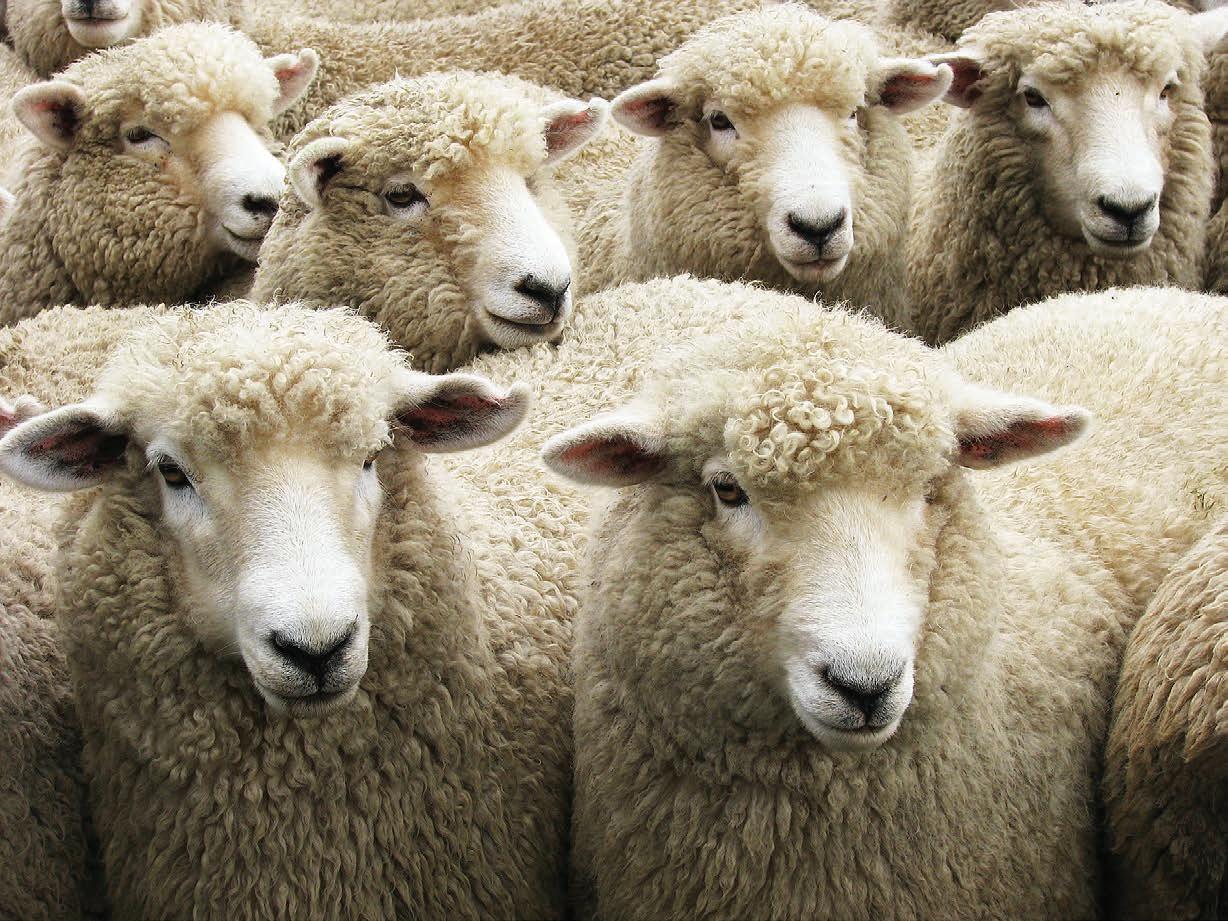
There have been some reports of customer resistance at current price levels.
Island $9.60/kg. At these levels, average export values this month would need to be steady, at least $13.80/kg for farmgate prices to be backed up by export returns.
Up until the first week in July, lamb cuts to the UK, United States and European Union have all remained steady in price, while
some lower-value cuts to China have shown modest firmness. This suggests that with consistency at this level, farmgate prices should still be supported by export returns, if July average export values were to show their usual upside.
So far this season, there has been no shortage of demand from our key export destinations. However, there may be some downside risk at the top end. The prices for some cuts into the UK and Europe are currently 40-60% above the five-year average. There have been some reports of customer
resistance at current price levels, suggesting that average export values may have be close to reaching a ceiling.
This year, high prices have been driven by supply shortages in key markets, with buyers willing to pay increasingly high prices to secure product. There has been little indication that global supply will recover next season, which should continue to support pricing. However, if demand begins to falter at current levels, there may be limited room for further export return gains while procurement pressures remain higher than ever.

PRICING: Although exporters have never received more for lamb, farmgate prices at $9.55/kg are still 10c/kg shy of breaking any records, says Alex Coddington.
Cattle Sheep Deer

Weekly saleyard results
These weekly saleyard results are collated by the AgriHQ LivestockEye team. Cattle weights and prices are averages and sheep prices are ranges. For more detailed results and analysis subscribe to your selection of LivestockEye reports. Scan the QR code or visit www.agrihq.co.nz/livestock-reports
Tuakau | June 30 | 900

Get ahead of the market
Rangiuru | July 1 | 386 cattle, 13 sheep
Make informed livestock trading decisions with AgriHQ. Track key saleyard, paddock and slaughter prices, market indicators, and forecast prices through a suite of reports. Customise your selection and access everything in one convenient platform: myAgriHQ.


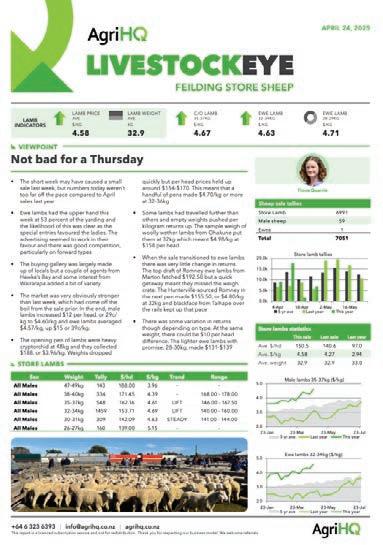
SOGGY MARKET: The wet weather put a cap on interest for store lambs at Temuka on Monday, June 30. These ewe lambs earned $156.
Stortford Lodge | June 30 | 1111 sheep
or $/hd Prime ewes, most 119-219 Prime lambs, most 194-231
Stortford Lodge | July 2 | 281 cattle, 3527 sheep
Mixed-age traditional cows, VIC and empty, 605kg 3.69
R2 dairy-beef steers, 385kg 4.30
Mixed-age Romney ewes, SIL, most 194-237
Store cryptorchid lambs, all 143-207 Store wether lambs, all 158-189.50 Store ewe lambs, most 130-165 Store mixed-sex lambs, most 127-175
Dannevirke | June 26 | 1225 sheep
Feilding | June 27 | 1897 cattle, 17,084 sheep
Feilding | June 30 | 69 cattle, 2511 sheep
Prime ewes, most
Prime 2-tooth ewes, most
Prime mixed-sex lambs, most
Rongotea | July 1 | 80 cattle, 27 sheep
R1 dairy-beef heifers, 230kg 823
Aut-born weaner dairy-beef heifers, 125kg 703

Coalgate | June 26 | 219 cattle, 3728 sheep
Prime traditional cows, 525kg
Prime traditional bulls, 480kg
Prime traditional heifers, 450kg
Prime dairy-beef heifers, 500kg
Mixed-age ewes, all
Store lambs, all
Prime ewes, all
Prime lambs, all
Canterbury Park | July 1 | 108 cattle, 2537 sheep
mixed-sex lambs, all
Prime ewes, most
Prime lambs, most
Temuka | July 2 | 6114 sheep
5-shear ewes, SIL, all
4-shear Romney ewes, SIL, all
3-shear Romney ewes, SIL, all
2-shear Romney ewes, SIL, all
1-shear Border Leicester-Romney ewes, SIL, all 232
2-tooth Romney ewes, SIL, all
Mixed-age Romney ewes, SIL, all
Mixed-age other breeds ewes, SIL, all
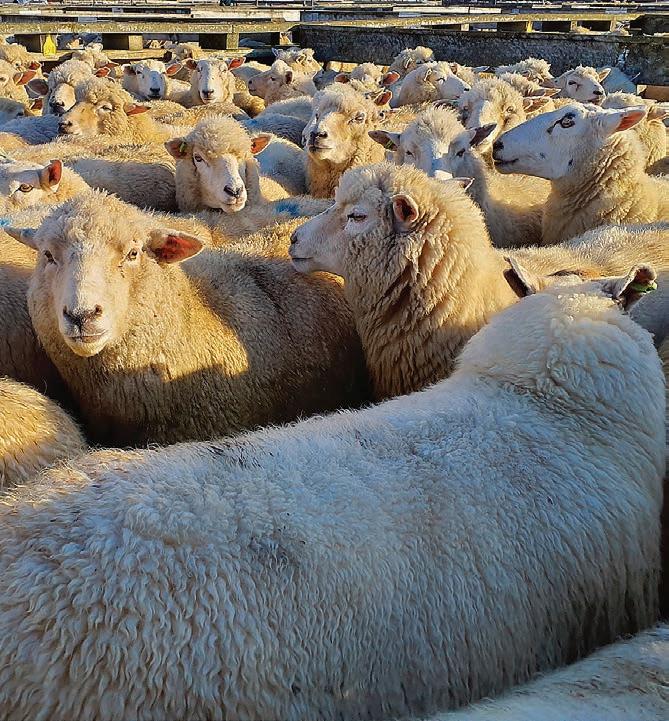

BUYERS STEP UP: It was a positive result at the Temuka inlamb ewe fair on Wednesday, July 2. These 2-shear Romney ewes from Geraldine fetched $245, scanned at 175% to Suftex from April 1.
Month of big weather doesn’t disappoint

Philip Duncan NEWS Weather
WATER tankers are being used in parts of Hawke’s Bay as stubborn drier-thanusual weather conditions remain.
Big rain events in recent weeks have bunny-hopped over parts of Hawke’s Bay, leaving them in a persistent rain shadow that has encouraged a soil moisture deficit.
Winter is typically when most of us get bogged down at some point with too much wet weather. That’s certainly been the case in places like Canterbury, Marlborough, Nelson, Waikato, Auckland and Bay of Plenty at times. On the government’s soil moisture maps, Hawke’s Bay is the only region in red, which means rainfall is more than 50mm below normal.
That dry area fades the further away from the Napier/Hastings area you get, but parts of northern Manawatū, Whanganui and the Volcanic Plateau are also drier.
There have been many dry days without a drop of rain around Napier to Hastings in particular. But not northern Hawke’s Bay – clipped by one
too many northern rain events, and also wet, showery, southerlies.
Over the years I’ve been writing these columns I’ve noticed that July is quite often “the month of big”.
We have some of our biggest, most powerful high pressure zones of the year usually between now and early spring (think 1040+ hPa).
We also have some of the biggest storms and lows as we head into peak winter.
So it’s probably no surprise that the focus of our recent ClimateWatch July Video Outlook was not only on the big lows we have crossing New Zealand lately, but also the powerful highs.
Almost the entire nation was over a degree warmer than normal.
This messy set-up has a pattern to it – and while some regions have had far too much rain, the sunny/dry spells between rain events are definitely helping to drain some of the water away.
The second half of June was warmer than you think. Cold days in winter are normal, so are frosts.
But just how cold and how frosty matters – and the data shows June’s second half was warmer than usual in many places (even after the polar air that stuck around the South Island and lower North Island at the start of June).
But the second half of the month had more subtropical and northerly flows in the mix.
As a result, almost the entire nation was over a degree warmer than normal. Remember, you can still feel cold even when it’s warmer than normal – for example, if it’s 5degC above normal, but the actual temperature is -10degC, you’re not going to notice it!
There were only two small parts of NZ that were average or below average in the second half of June: 1) Once again, the Napier area and just southwards down the eastern coastline into Manawatū; and 2) Mackenzie Country.
But these are small cool dots in the big picture of warmer.
Usually those on the northern fringes of NZ’s cold can notice a slightly warmer winter more than others – Waikato, for example, is normally very frosty by July – but there have only been one or two frosts so far that far north, and they were light.
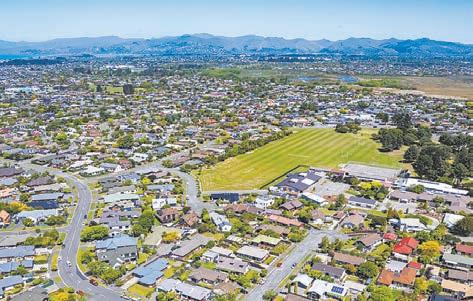



COMPARISON: This map shows the Mean Temperature Anomaly – in other words, which areas have been milder or cooler than previous Julys.






















